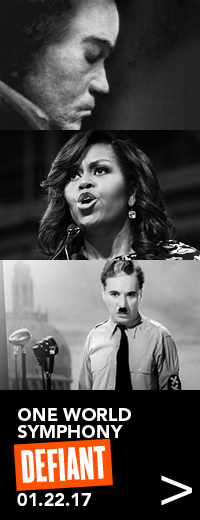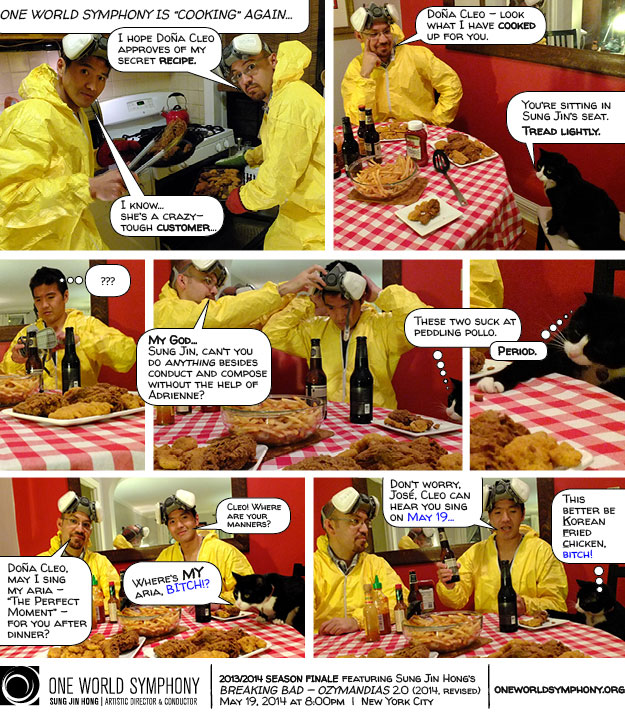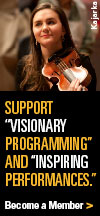Breaking Blog
by Sung Jin Hong
Sept 25 Seoul-Searching • April 11 Pet Pin-Ups • Mar 29 DEFIANT Video Premiere • Jan 15, 2017 SAVI Interview • Dec 21 Defiant • Jul 24 Remembering Lloyd Arriola • Jan 07 Is The Force Strong • Nov 4 Thanking all Fannibals and Music Lovers! • Oct 25 Bryan Fuller tweets about the world premiere of Hannibal (2015) • Oct 20 The Daily Dot & Hannibal Cast • Oct 9 Interview with Cardiologist Dr. Steven Markowitz • Oct 5 Which Fach Will Sing Hannibal Lecter? • June 3 Hannibal: Teaser Trailer • May 13 The Cook, the Composer and His Cat • April 24 Heisenberg's Resurrection • Feb 26 Classic FM Exclusive! • Feb 02 Vote & Break Bad Again • Jan 14 Revealed: Breaking Bad – Ozymandias • Jan 13, 2016 Cast of Breaking Bad – Ozymandias • Dec 5 Tweak of Chemistry • Oct 22 Bitch Aria • Oct 16 BBC feature • Oct 7 Breaking Bad — Ozymandias
 Seoul-Searching Through the Mountains of Korea
Seoul-Searching Through the Mountains of Korea
and Celebrating 1,700 Years of its Culinary Heritage with Buddhist Chef Beop Song and Ven. Soo Am
(Published on Canada's online magazine Schmopera)
For nearly 1,700 years before terms like sustainability, authenticity, mindfulness, transparency, homegrown, and locally-sourced became common vernacular in the West, Korean Buddhists were cultivating an intimate relationship with food. For these awakened sowers, it’s beyond “from farm to table” — it’s from nature to the mind, from the earth to the body, from the community to the soul.
Korean Buddhism was re-introduced to me when I returned to my homeland, nearly a quarter of a century after my family and I immigrated to America. My wife Adrienne and I hiked the mountains of Korea during its harvest festival called Chuseok (추석). Buddhism, which has deeper cultural roots than Christianity, was suppressed for centuries by Confucianists. The Buddhists’ banishment into the mountains was transformed into a gift of grace. Not only did they meditate and build temples in their re-discovered sanctuary, but they established strong bonds with the people and returned to their provenance: nature.
That sincere relationship with their community was clearly evident during our exploration of two mountains: Seoraksan in Gangwon Province and Hallasan on Jeju Island. A radiant mosaic of autumn forests vaulted above us as we ascended towards cloud-shrouded altars. Along the way, we were met by Buddhists who offered rice balls, sweet potatoes, and half-moon-shaped rice cakes called songpyeon (송편) without expecting anything in return. This gesture reminded me of how both my grandmother and mother ceaselessly contributed with a sense of 기쁨 (gippeum — purity and bliss).
After the momentous climb to the summit of Daecheongbong (the highest peak in Seoraksan), Adrienne and I experienced one of our most memorable meals together in the little village nestled in the valley below. The entirely vegetarian fare was curated using ingredients directly sourced from Seoraksan’s terrain. The chef de cuisine prepared a symphony of mountain vegetables (산 나물 san nammeul and 취나물 chwinamul), an assortment of earthy mushrooms, braised lotus roots (연근조림 yeongeun jorim), fermented soybean paste stew (된장찌개 deonjang jigae), potato pancakes (감자전 gamjajeon), our first taste of a most delectable grilled root (더덕 deodeok-gui), and, of course, kimchi (김치).
If The Rite of Spring “kissed the earth” through a savagely primitive lens, that temple-food-inspired table celebrated our planet's primordial bounty from a more intimate perspective. The meal was prepared using centuries-old methods and crafted with ingredients that shared their origins with the mountains themselves. Traditional Korean cooking has nurtured a patient alchemy, where delicacies, seasoned with time to develop deep undercurrents of flavor, emerge transformed.
This pilgrimage to my homeland during Chuseok — a time for giving thanks, celebrating the harvest, and honoring our ancestors — overwhelmed me with memories of my grandfather. Before he passed away, he wanted us to explore together the traditions, wisdom, and resilience of our people and our land — weathered as they were through a cultural genocide resulting from Japanese imperialism; World War II, the Western division of Korea with the arbitrary institution of the 38th Parallel, occupation by the Soviet Union and United States, the first phase of the Cold War and the deliberately erased slaughter of at least three million Korean civilians during the full-scale bloodshed of the Korean War (euphemistically labeled a “conflict”), mass industrialization, and the fierce acceleration of the rhythm of life. My grandfather dreamed of journeying with me into the sacred mountains that not only shaped my motherland's landscape and heritage, but forged her identity.
He longed for us to be in the moment: past, present, future… time flowing eternally…
 Interview with Beop Song and Venerable Soo Am
Interview with Beop Song and Venerable Soo Am
When Adrienne and I were invited to Opening Night of the 2017 Korean Templestay and Temple Food Cultural Week in New York City, I couldn’t help but feel grateful for my pilgrimage to my homeland. Reflecting on our temple food-inspired experience made me wonder if we can build a more balanced and compassionate world by embracing some of the Korean Buddhist social values:
A spirit of equality: Regardless of one’s social standing, all participants sit together and share meals without class distinction. All are equal.
A spirit of community: All are nourished from food grown and harvested from the same garden, prepared in the same pot, in the same place, and at the same time — sowing the seeds of solidarity.
I offer my sincere gratitude to Beop Song, Korean Buddhist nun, chef, and author; Venerable Soo Am, Cultural Corps of Korean Buddhism director; and the Jogye Order of Korean Buddhism for hosting this generous festival. Venerable Soo Am and Beop Song graciously consented to sit for an interview:
1.
SJH: Can you please tell us about Korean Templestay and Temple Food and how they actively serve the local and global communities? What is the essence of Korean Templestay and Temple Food?
Ven. Soo Am: Templestay is a cultural experience centered around the heritage of Korean Buddhism and its traditional temples. However, these activities are not limited to the space of just the temple grounds. Templestay is conducted in connection with the culture, environment and attractions of the community near where the temple is situated. In addition, the temple itself assumes the characteristics of that local community. Temple food is prepared from the native seasonal ingredients. Temple stay and temple food are the encounters of the past and the present co-existing with the community.
The essence of Templestay and temple food is to share in the value of spiritual impressions and community. The experience of traditional Buddhist culture in Korea embraces the diversity of country, race, gender, or beliefs. Through the experience of traditional Korean Buddhist culture, we can enrich our understanding of different cultures and exchange their ideas. Spiritual reflection through Buddhist culture experience can deepen and enrich one's own mind and perspective.
The traditional Buddhist culture of Korea values the relationships between you and me, the world and me, and between all beings.
2.
SJH: What is enlightenment in Korean Buddhism?
Ven. Soo Am: Enlightenment of the Buddha can be called "middle way(中道) and arising from causation (緣起)." Freeing the pair of polar opposites, it is the wisdom of seeing reality as it truly is that enables us to look at all phenomena and objects clearly, and the understanding that all beings in the world are interconnected to each other. Enlightenment is not merely a comprehension. The enlightenment must be awakened whether or not one is walking, staying, sitting, lying down, talking, silencing the mind, moving or stopping. The enlightenment (awakening of consciousness) is both understanding and practice.
3.
SJH: Food that one has planted, harvested, and prepared with love, compassion, and mindfulness of our ecological footprint is believed to purify and nourish the mind, body, and soul. This ideal appears to be only a small part of one’s journey in Korean Buddhism. Can temple food help one discover or achieve enlightenment?
Beop Song: It is the spirit of temple food that encourages one to deeply think, appreciate, and meditate on the food one is eating, the whole process from the origins and existence of food. It means to free the body and the mind in order to concentrate on spiritual practice and realize enlightenment without the ego. The food itself cannot lead to enlightenment. The process of eating is a vital practice starting with how to eat which food. Enlightenment can only come from within, through the process of achieving certain state of body, mind, and awareness.
4.
SJH: Can you please tell us a little about Korean Buddhism (Seon) and how it is unique? How does it continue to be relevant today?
Ven. Soo Am: Korean Buddhism has continued the tradition of Zen Buddhism. The Zen (Seon) of Korean Buddhism is called Ganwha Seon (看話禪), a way of practicing the quest for Hwadu (話頭), or key phrase or story. It is also referred to as Cham Seon (參禪). Traditionally, there are about 1,700 different Hwadu, so it is called “1700 Gong-an (if the gong-an is the context of the dialogue, hwadu is a key word or a phrase of the dialogue). "What's this?" "Pine tree in front of the yard," and "There is no Buddha in a dog" are some of the well known Hwadu.
The distinct feature of Korean Buddhism is "Tong Buddhism" (The intermediate or holistic teaching). Although Tong Buddhism has continued the tradition of Seon Buddhism, it is based on the idea of Hoitong (會通; Conciliation or balance of diverse opinions). In the idea of Hoitong, one can realize enlightenment by accepting and respecting the following as the way of practice: silent reading of a sutra, Buddha chanting, the power of the earnest chanting of mantra, the belief in the Pure Land (淨土信仰), and so on. By these traditions, various Buddhist sects and philosophies of today are in harmony, and they are the basis for practicing to realize enlightenment for each one's potential.
 5.
5.
SJH: Who or what was your inspiration to become a Buddhist and a chef? Was there a specific individual, event, or moment? Which came first, Buddhist or chef?
Beop Song: I received my first opportunity to cook as a nun was when I was an apprentice. I watched and assisted in preparing the ingredients. In this way, I was able to see the techniques Buddhist nuns used to prepare food. Gradually, I learned the food culture of the temple naturally by closely observing the process. My mentor taught me the importance of the seasonal foods she made for the head nuns and how to savor them. The reason that I wanted to prepare food as a nun was to experience the sharing, warmth, gratitude, and caring that was fostered by my mentoring nun.
Cooking is just a part of the spiritual practice. Buddhism comes first.
6.
SJH: If you had the opportunity to host a dinner summit for peace and solidarity with the respective leaders of Russia, China, the United States, Japan, and the Koreas, what would be on the menu? And why?
Beop Song:
Red bean sticky rice and shiitake mushroom seaweed (미역) soup – These two are considered as special food because monks have these on the day of shaving twice a month. These food circulate and supplement the "chi" ("gi").
Grilled tofu — Nutritious food for monks
Grilled Seaweed (김) — It complements sticky rice.
Sir-fried vegetables with sweet potato noodles (잡채) — This is the food using all seasonal vegetable made for special guests in temple all vegetables.
Kimchi (SJH: Temple food kimchi is rooted from the original, dated around 7th century A.D. in Korea, where it's lighter in color and less spicy)
7.
SJH: Through the official website of Jogye Order of Korean Buddhism, I read about the Manhae Grand Prize commemorating the life and achievements of Buddhist, activist, and resistance poet “Manhae” Han Yong-un (한용운, 1879–1944). Han fought for the Re-Independence of Korea during Imperial Japan. In 2014, The Manhae Peace Prize was granted to the “House of Sharing,” a home for the surviving few of the over 200,000 women who had been systematically victimized as sexual slaves during the Japanese Imperialism of Korea and WWII (euphemistically called “comfort women”). These 할머니s (halmonis, grandmothers) have embraced the Jewish Holocaust mantra of “Never forget!” by continuing to fight as human right's activists in the “world’s longest-running protest” that has been held every Wednesday for the last 25 years. If you had the opportunity to prepare a meal for the courageous halmonis, what would you serve to nourish and empower their bodies, minds, and souls? And why?
Beop Song:
White rice – This is the food that could only be eaten on special occasions during the Japanese imperialism, when many were starving.
Miso soup with tofu and zucchini — This is the food that reminds you of home without getting tired of eating it all year round.
Grilled root (더덕구이) — The aroma of root brings you nostalgia and supplements the "chi" ("gi") *Steamed Potatoes: This food is empathetic with sorrow from the hunger period
Winter-cabbage water kimchi — It goes well with potatoes and the cleansing kimchi water prevents upset stomach and has a refreshing flavor.
Azalea rice pancake (진달래 화전) and radish water kimchi (동치미) — I’d like to respect and honor our halmonis (grandmothers) by preparing the spring azalea pancake. I’d like to add the refreshing radish water kimchi to foster the truth and resolution of our halmonis.
8.
SJH: What message would you like to share with all the guests who will be celebrating 1,700 years of Korea's culinary heritage?
Ven. Soo Am: The tradition of Temple food in Korea is very old and has experienced numerous practices for centuries. All of us together here and now, eating this food, will continue the tradition for another thousand years. Looking at the food before us, I would like to express gratitude and prayers of thanksgiving, peace and happiness to all beings in the world.
The responses from Ven. Soo Am and Beop Song were originally in Korean. Translation by chemist Jae Hyoun Lee, Ph.D and Sung Jin Hong.
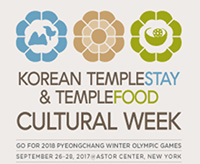 The fourth annual Korean Templestay and Temple Food Cultural Week will be held from September 26–28, 2017 in New York City. In honor of the 2018 Pyeongchang Winter Olympics, the festival will offer a wide range of events, including tastings, cooking demonstrations and instructions, exhibitions, lectures, and guided workshops on woodblock printing, lotus lanterns, arts, and crafts via advanced registration.
The fourth annual Korean Templestay and Temple Food Cultural Week will be held from September 26–28, 2017 in New York City. In honor of the 2018 Pyeongchang Winter Olympics, the festival will offer a wide range of events, including tastings, cooking demonstrations and instructions, exhibitions, lectures, and guided workshops on woodblock printing, lotus lanterns, arts, and crafts via advanced registration.
For more information visit koreantemplefood.com
All food photography is courtesy of Korean Templestay and Temple Food.
Original responses in Korean:
1.
템플스테이(사찰음식)는 한국불교와 전통 사찰이 지니고 있는 문화유산을 바탕으로 한 문화 체험의 장입니다. 그러나 이러한 활동은 단순히 사찰 경내라는 공간만으로 한정되지는 않습니다. 템플스테이는 사찰이 있는 지역 사회의 문화와 환경, 명소와 연계하여 이루어지고 있습니다. 또 사찰 자체가 그 사찰이 머물고 있는 지역의 특성을 고스란히 간직하고 있는 곳이기도 합니다. 사찰음식은 그 지역에서 제철에 나는 식재료를 바탕으로 만들어집니다. 템플스테이와 사찰음식은 지역 사회와 함께 존재하고 어우러져 이러지고 있는 과거와 현재의 만남입니다.
템플스테이와 사찰음식의 본질은 종교적 감동과 공동체의 가치라고 할 수 있습니다. 한국의 전통불교문화 체험은 국가나 인종, 종교의 다양함에 폐쇄적이거나 차별적으로 이루어지지 않습니다. 한국 전통불교문화 체험을 통해서 서로 다른 문화에 대한 이해와 교류를 더 풍부하게 해 나갈 수 있습니다. 불교 문화 체험을 통한 종교적 감동은 각자 자신의 종교적 심성을 더욱 깊고 풍성하게 해줍니다.
한국의 전통불교문화는 나와 남, 세상과 나, 이 세상의 모든 존재와 관계가 소중함을 담고 있습니다.
2.
부처님께서 이루신 깨달음을 요약한다면 ‘중도(中道)와 연기(緣起)’라고 할 수 있습니다. 양극단을 여의고 모든 현상과 사물을 올바로 바라볼 수 있는 여실지견의 지혜와, 세상의 모든 존재는 서로 연관되어 있음을 명확하게 깨닫는 것이라고 할 수 있습니다. 이 깨달음은 단순히 이해하는 데에 머무르지 않습니다, 걷고 머물고 앉고 눕고, 말할 때나 침묵할 때나 움직일 때나 멈춰 있을 때나 언제나 깨어 있는 상태여야 합니다, 즉 깨달음은 이해이자 실천입니다.
3.
내가 지금 먹고 있는 음식, 이 음식이 오기까지의 모든 과정과 존재를 깊이 생각하고 감사하는 마음을 가져야 한다는 것이 사찰음식의 정신입니다. 욕심내지 않고 함부로 다루지 않으며 수행에 집중하고 깨달음을 이룰 수 있을 정도의 몸과 마음을 유지하는데 사찰음식의 의미가 담겨 있습니다. 음식 그 자체로 무조건 깨달음을 이룰 수는 없습니다, 먹는 것 자체가 매우 중요한 수행입니다, 어떤 것을 어떻게 먹느냐는 출발은 어떤 몸과 어떤 마음을 이루느냐는 과정을 거쳐 결국은 깨달음에 이르게 되는 것입니다.
4.
한국불교는 선불교의 전통을 이어오고 있습니다. 한국불교의 선은 간화선(看話禪)이라 하여 화두(話頭)를 참구하는 수행 방법입니다. 화두를 참구(參究)한다 하여 ‘참선(參禪)’이라고도 합니다. 전통적으로 전해오는 화두는 1700여 가지가 있어 이를 ‘천칠백공안(公案)’이라고 부릅니다. ‘이뭣고?’, ‘뜰 앞의 잣나무’, ‘개에게는 불성이 없다’ 등이 많이 알려진 화두입니다.
5.
스님으로써 요리를 하시게 된 계기는 처음 절에 들어가면서 행자 기간을 거치면서 할 수 있는 것이 향적실(공양을 하거나 반찬을 만드는 곳)에서 음식하는 것을 직접 눈으로 보거나 식재료를 다루거나 하는 것이었습니다. 스님이 먼저 되신 분들이 사찰음식을 어떻게 하시는 것을 보는 것이었습니다. 이러한 것을 보면서 자연스럽게 절의 음식 문화를 서서히 익히게 되었습니다. 은사스님께서 사계절의 음식을 상좌들에게 손수 만들어 주시는 것을 보고 직접 먹어보고 음식의 중요함과 맛을 알았습니다. 은사스님으로부터 음식의 나눔, 따듯함, 감사함, 배려를 느끼게 된 것이 스님으로써 음식을 하게 된 가장 큰 이유입니다.
6.
• 팥 찰밥, 표고버섯 미역국: 한 달에 두 번 스님들이 삭발하는 날이 있는데 기가 통하고 보충해 주는 음식이기 때문에 위의 음식 이 사찰에서는 귀한 음식으로 여겨지기 때문이다.
• 두부구이: 스님들의 영양식
• 김구이: 찹쌀밥에 잘 어울림
• 잡채: 모든 야채(제철야채)를 이용하여 만든 잡채는 귀한 손님이 오셨을 때 절에서 만드는 음식이다.
• 김치
7.
• 하얀 쌀밥: 일제 강점기 시절 잘 못 먹던 시절, 쌀밥은 귀하고 특별한 날에만 먹을 수 있었던 음식으로 특별한 날에만 먹을 수 있었다.
• 두부와 호박을 넣은 된장국: 1년 내내 먹어도 질리지 않고 고향을 생각나게 할 수 있기 때문이다.
• 더덕구이: 더덕의 향은 향수를 느낄수 있고 기를 보충해 준다.
• 찐감자: 배고플 때 한이 서려있는 음식이다.
• 얼갈이 물김치: 감자와 잘 어울리며 물김치 궁물은 체하는 것도 예방하고 시원한 맛을 느낄 수 있기 때문이다.
• 진달래화전, 동치미: 위안부 할머니의 아름다운 시절을 봄날의 화전으로 보상해드리고 싶고, 위안부 문제가 속 시원하게 해결될 수 있도록 동치미를 곁들이고 싶다.
8.
한국의 사찰음식은 오랜 세월을 거쳐 왔습니다, 그 오랜 세월을 수많은 수행의 전통으로 이어 왔습니다. 지금 이 시간, 사찰음식을 함께 먹는 우리들 모두가 또 다른 천 년을 이어나갈 수행자들입니다. 지금 우리 눈앞의 음식을 보며 세상 모든 존재들에 대한 감사의 마음, 평화와 행복을 기원하는 거룩한 기도의 시간을 함께 하기를 바랍니다.
Pet Pin-ups: One World Symphony Celebrates National Pet Day
Today is dedicated to raising awareness about animal welfare, encouraging people to help animals in shelters find forever homes. Those who aren't prepared to provide a forever home may consider contributing by volunteering at a local shelter or rescue organization. We at One World Symphony are grateful to celebrate two refuges in our lives: the arts and animals.
"The love of all living creatures is the most noble attribute of man." – Charles Darwin
Please wait a moment for the slideshow to load. If you wish to advance to the next slide, click on the blue dots below the slideshow.
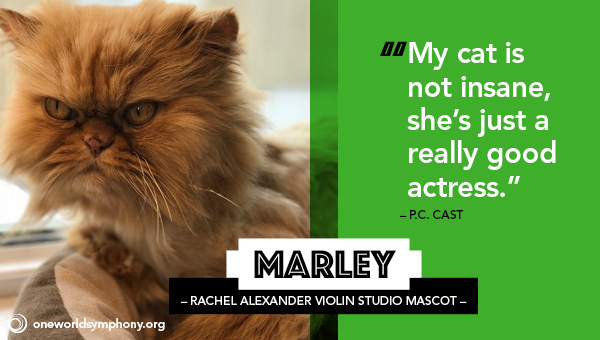
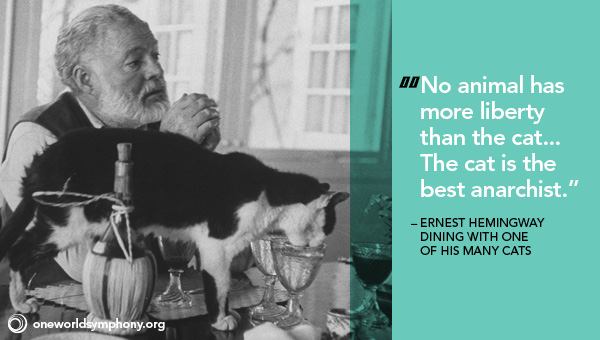
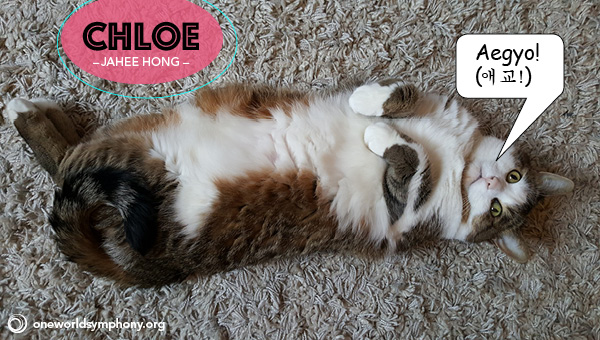
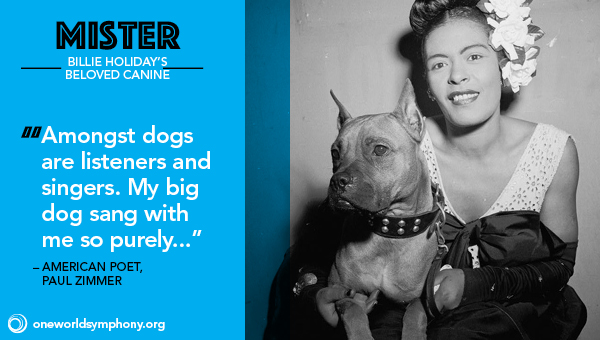

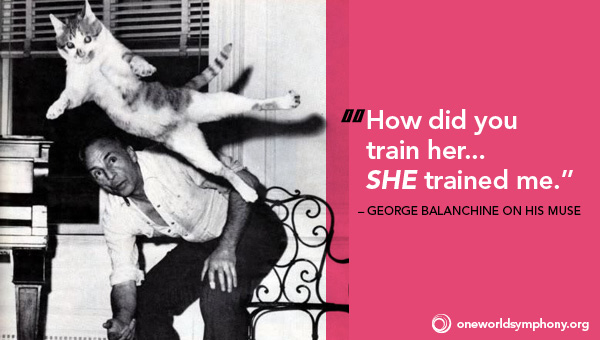
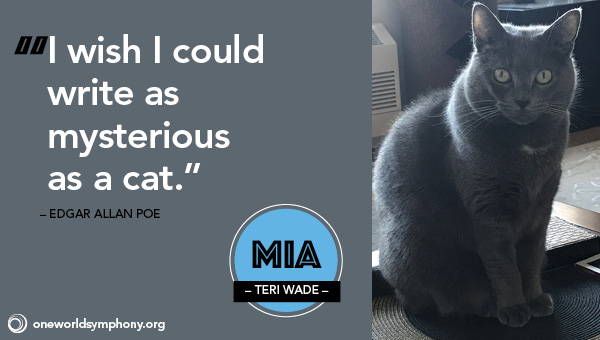
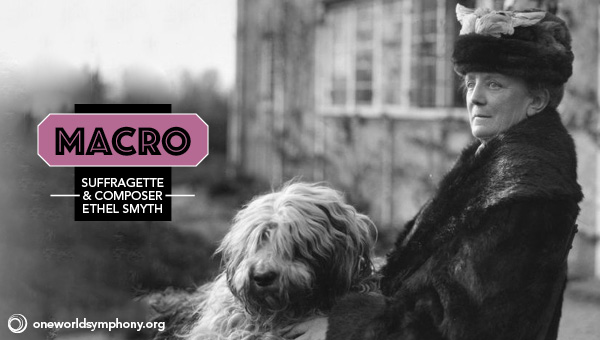
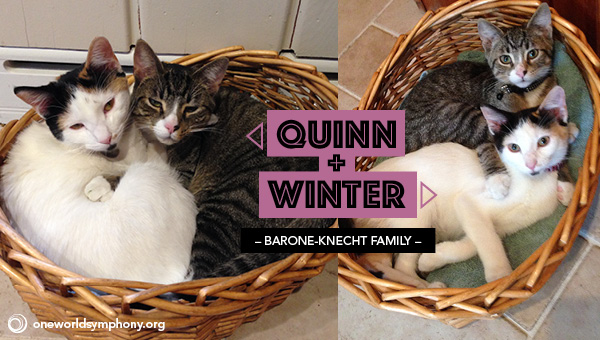
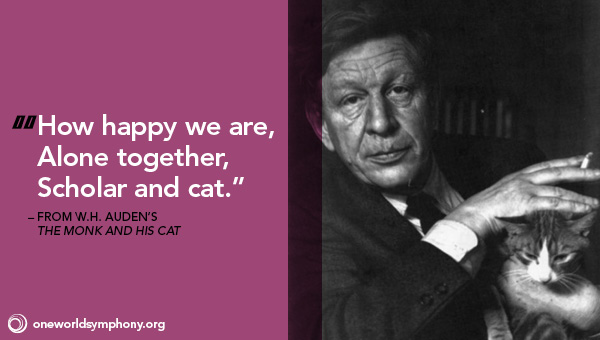
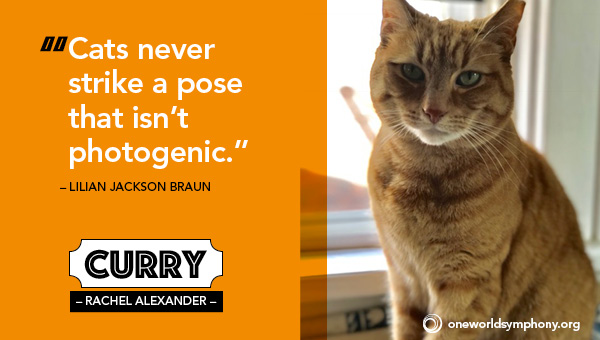
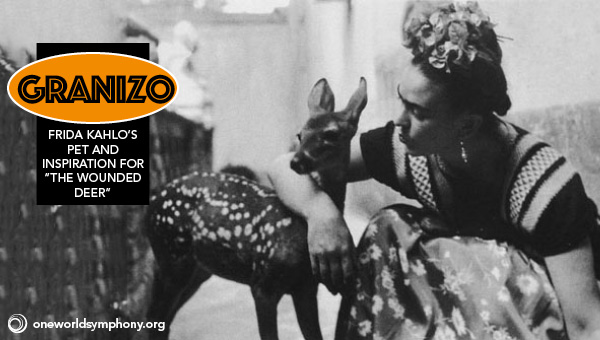
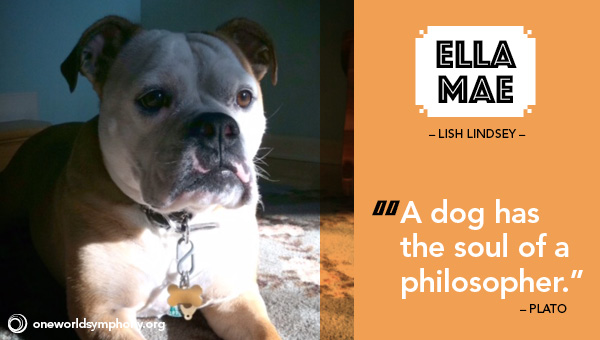
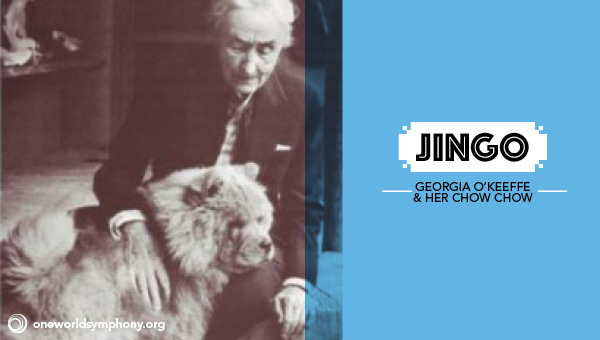
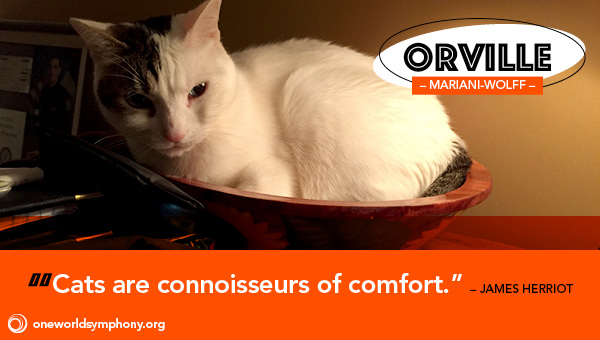
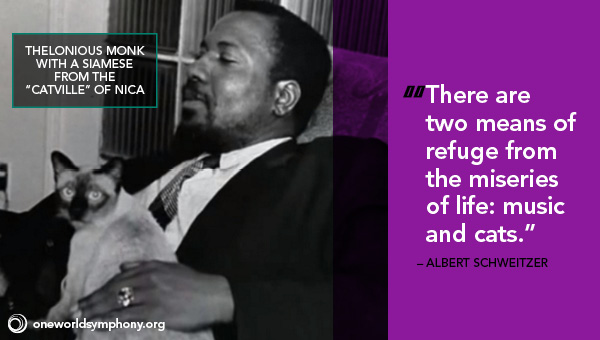
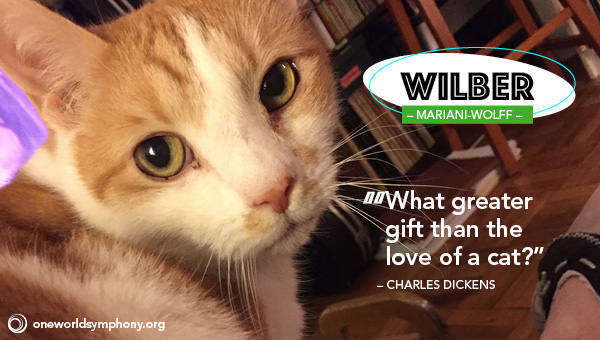
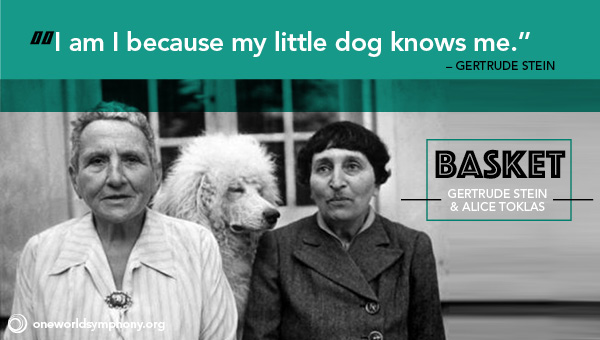
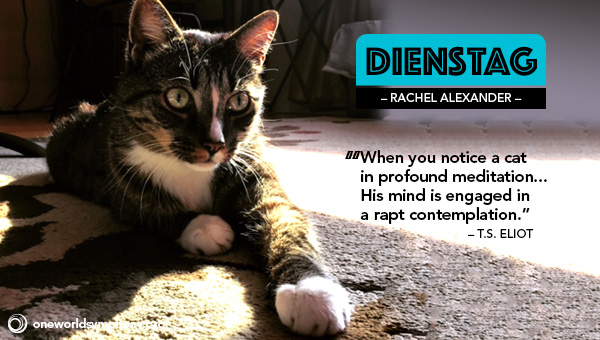
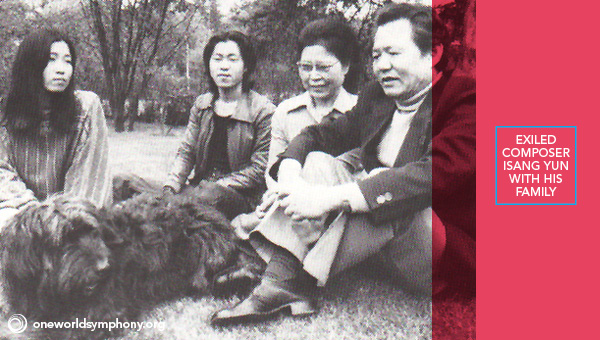
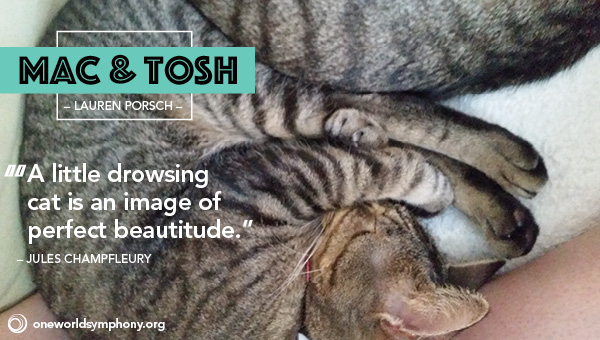

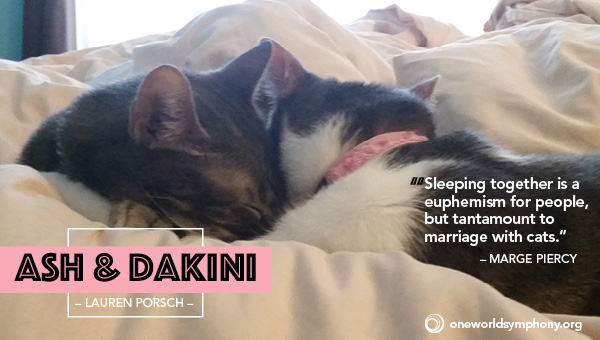
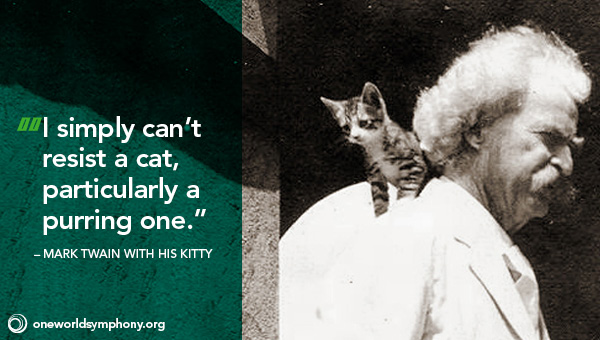
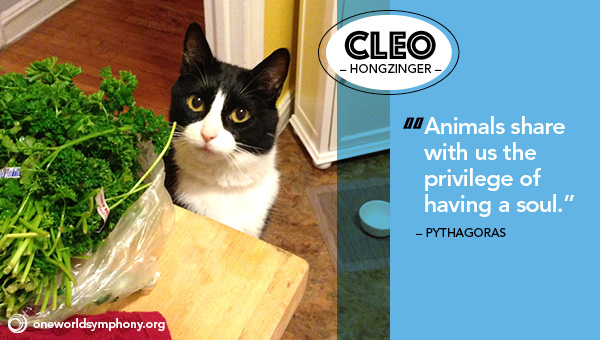
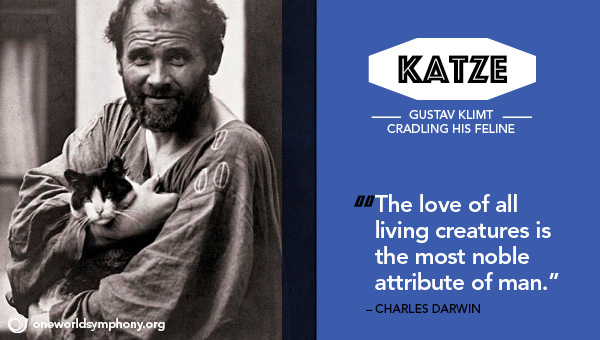
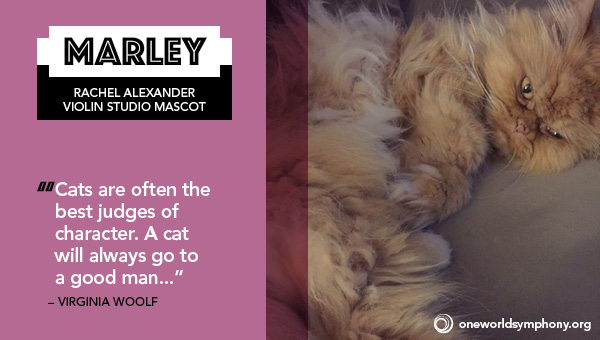
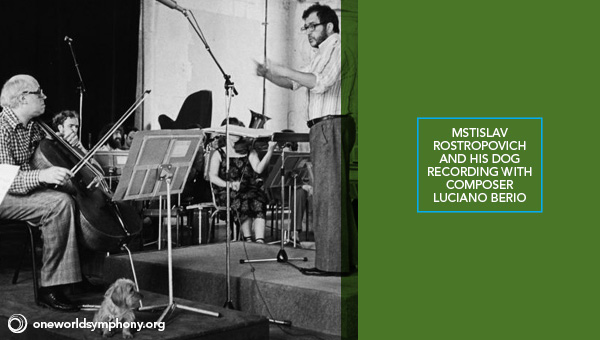
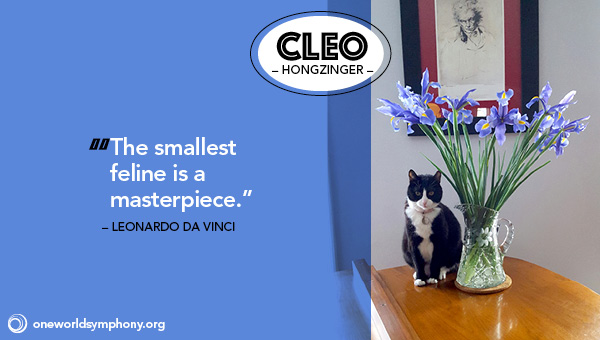
One World Symphony's crticially-acclaimed production of Janacek's The Cunning Little Vixen benefitted the Humane Society of New York.
Video Premiere from DEFIANT: The River, Dream Deferred, The Great Dictator, Michelle Obama: Shaken me to my core
 Sung Jin Hong: DEFIANT (2017 world premiere), a symphonic poem with four interconnected movements:
Sung Jin Hong: DEFIANT (2017 world premiere), a symphonic poem with four interconnected movements:
I. “The River” (Hangang, 한강)*
II. “Dream Deferred”
(inspired by the Langston Hughes poem)
III. “New World” from Charlie Chaplin's
The Great Dictator *
IV. “Michelle Obama: Shaken me to my core”
(with live audience chanting MLK Jr.'s words)*
*selections featured on 7-minute video. Length of complete DEFIANT is approximately 26 minutes.
Notes are from the composer and One World Symphony artists who performed DEFIANT at the world premiere on January 22, 2017 in NYC.
I. “The River” (Hangang, 한강) – excerpt featured on video
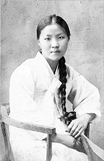 Freedom and “a land flowing with milk and honey” were promised to Moses and the Israelites, according to the Hebrew scriptures. Uprooted Koreans who survived the Asian Holocaust; the systematic destruction of language and cultural identity; sexual violence; and the silenced atrocities during Japanese imperialism and World War II believed in reclaiming their heritage by returning to their homeland. My grandmother, after the U.S. atomic bombings of Hiroshima and Nagasaki and recent bearing of her third child (my mother), led the exodus of her family out of Imperial Japan’s oppression through her unshakable faith in the Mosaic covenant.
Freedom and “a land flowing with milk and honey” were promised to Moses and the Israelites, according to the Hebrew scriptures. Uprooted Koreans who survived the Asian Holocaust; the systematic destruction of language and cultural identity; sexual violence; and the silenced atrocities during Japanese imperialism and World War II believed in reclaiming their heritage by returning to their homeland. My grandmother, after the U.S. atomic bombings of Hiroshima and Nagasaki and recent bearing of her third child (my mother), led the exodus of her family out of Imperial Japan’s oppression through her unshakable faith in the Mosaic covenant.
 With much pain in her voice, my grandmother told me her family’s return to provenance was anything but a Fertile Crescent. The complete destruction of a nation shook her to her core. With some historical perspective, she reminded me that the Nazis did not destroy France’s pride, the Eiffel Tower, the Arc de Triomphe, the Louvre, or Notre Dame; and Olivier Messiaen was given manuscript paper and a piano to compose and perform the world premiere of Quatuor pour la fin du temps at Stalag VIII-A in 1940. When she asked me which monument best represented the Korean spirit, unfortunately, I couldn’t even name one temple. While burning down palaces, monuments, and temples, she told me, Imperial Japan focused on systematically destroying Korea’s national treasure and palace: Gyeongbokgung.
With much pain in her voice, my grandmother told me her family’s return to provenance was anything but a Fertile Crescent. The complete destruction of a nation shook her to her core. With some historical perspective, she reminded me that the Nazis did not destroy France’s pride, the Eiffel Tower, the Arc de Triomphe, the Louvre, or Notre Dame; and Olivier Messiaen was given manuscript paper and a piano to compose and perform the world premiere of Quatuor pour la fin du temps at Stalag VIII-A in 1940. When she asked me which monument best represented the Korean spirit, unfortunately, I couldn’t even name one temple. While burning down palaces, monuments, and temples, she told me, Imperial Japan focused on systematically destroying Korea’s national treasure and palace: Gyeongbokgung.
 In the midst of desolation and shattered dreams, the only sign of life for the Korean refugees was the flowing Hangang (한강). Considered the soul of Seoul, the Han River gave my grandmother strength to continue her journey to re-plant her family roots in Korea. She also taught me the importance of etymology and to never allow oppressors and imperialists to control the narrative of our language, such as Han (한). After more than quarter of a century of contemplation, I discovered clarity in the genesis of the word Han. Our contemporary culture encourages a concept of nonattachment and "liberatingly" unsentimental worldview. Deeply rooted in humanity, empathy, and tears that flow like an underground river due to centuries of atrocities, 한 (Han) is a bridge to one’s provenance and soul, with hope for shared defiance and fulfillment.
In the midst of desolation and shattered dreams, the only sign of life for the Korean refugees was the flowing Hangang (한강). Considered the soul of Seoul, the Han River gave my grandmother strength to continue her journey to re-plant her family roots in Korea. She also taught me the importance of etymology and to never allow oppressors and imperialists to control the narrative of our language, such as Han (한). After more than quarter of a century of contemplation, I discovered clarity in the genesis of the word Han. Our contemporary culture encourages a concept of nonattachment and "liberatingly" unsentimental worldview. Deeply rooted in humanity, empathy, and tears that flow like an underground river due to centuries of atrocities, 한 (Han) is a bridge to one’s provenance and soul, with hope for shared defiance and fulfillment.
Imperialists and oppressors may claim to be "protectors" and plan to build impenetrable walls, but the river will run through.
– Sung Jin Hong, Composer
Rivers are defiant, wild, and bold, and always eventually move forward. The same can be said of humanity and social progress. The beauty is that no matter the obstruction, the river will find a way around it. Rivers will erode even the most unyielding obstacles. What is not eroded will be left behind as the river progresses forward.
– Sonya Headlam, One World Symphony DEFIANT vocal artist
II. “Dream Deferred” (inspired by the Langston Hughes poem)
More than a decade before the visionary and non-violent defiant Martin Luther King, Jr. gave hope to the oppressed, Langston Hughes realized the obstacles to true emancipation, acceptance, and opportunity in America. He voiced these “unanswered” questions that beg to be asked again and again:
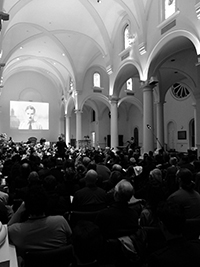 “What happens to a dream deferred?
“What happens to a dream deferred?
Does it dry up Like a raisin in the sun?
Or fester like a sore — And then run?
Does it stink like rotten meat?
Or crust and sugar over — like a syrupy sweet?
Maybe it just sags like a heavy load.
Or does it explode?”
How are we going to respond?
– Sung Jin Hong
III. “New World” from Charlie Chaplin's The Great Dictator– excerpt featured on video
The last speech from The Great Dictator is about humanity — or more specifically, a return to humanity. A return to feeling and kindness. Chaplin’s emotionally-charged words don’t just serve to condemn the failings of our world, but to deliver hope. He requests that we do not despair. He appeals to human emotion and concern. But, perhaps most importantly, he lets us know that WE have the power to be stewards for change:
“You, the people, have the power to make this life free and beautiful, to make this life a wonderful adventure… let us use that power — let us all unite. Let us fight for a new world...”
– Adrienne Metzinger, One World Symphony DEFIANT vocal artist
 IV. “Michelle Obama: Shaken me to my core” (adapted from Michelle Obama’s speech on October 13, 2016) – excerpt featured on video
IV. “Michelle Obama: Shaken me to my core” (adapted from Michelle Obama’s speech on October 13, 2016) – excerpt featured on video
Michelle Obama’s powerful words highlight the double bind contemporary women face: speak out about the ongoing and systemic violence, harassment, and degradation we face and risk retribution, or swallow the shame and the fear. Either experience can be humiliating, terrifying, and isolating. It can shake you to your core. But the First Lady also reminded us of the importance of coming together as a community to defend the values of equality and opportunity that Americans hold dear. “We reject hatred and fear, and in difficult times, we don’t discard our highest ideals. No, we rise up to meet them.”
— Lauren Porsch, One World Symphony DEFIANT vocal artist
Video Premiere of DEFIANT: The River, Dream Deferred, The Great Dictator,
Michelle Obama: Shaken me to my core by Sung Jin Hong
(Trouble viewing this video? Watch it here.)
Video premiere of DEFIANT (2017 world premiere)
An original symphonic poem with four interconnected movements by Sung Jin Hong
I. “The River” (Hangang, 한강)*
II. “Dream Deferred” (inspired by the Langston Hughes poem)
III. “New World” from Charlie Chaplin's The Great Dictator *
IV. “Michelle Obama: Shaken me to my core” (with live audience chanting MLK Jr.'s words)*
One World Symphony
One World Symphony Concertus
One World Symphony live audience
Sung Jin Hong, composer-conductor
Recorded live on January 22, 2017 in New York City. Unmastered and unedited.
Video conception and direction: Sung Jin Hong
Video design and production: Adrienne Metzinger
Collaboration and Interview with SAVI
Passion. Purpose. Protests that still continue to inspire transformative change were led by the visionary and non-violent defiant, Martin Luther King, Jr.
At the heart of the Civil Rights movement, his voice instilled hope within the oppressed: “Transform the jangling discords of our nation into a beautiful symphony of brotherhood” and “Dream that one day this nation will rise up and live out the true meaning of its creed.”
More than a half a century later, on October 13, 2016, Michelle Obama not only condemned the abuse and harassment of women, but — like Dr. King — she charged us all to unite and “stand up and say enough is enough.... We reject hatred and fear, and in difficult times, we don’t discard our highest ideals. No, we rise up to meet them. We rise up to embody the values of equality and opportunity and sacrifice.”
Violence and systematic crimes against women have been deeply personal for me. My family and my homeland have suffered and been victimized for generations. The erasure of such atrocities has been burning in my heart for many years. Together with the devoted artists of One World Symphony, I feel it is a powerful gift to be able to defend the values of equality and embrace the alchemies of transformation and interconnectedness through our art.
 Since our first concert in October 2001, One World Symphony has actively fulfilled our vision of integrating ourselves into the fabric of our local and global communities through benefit concerts and community collaborations. Every year, for nearly 16 years, One World Symphony has raised funds and awareness for groups that serve humanity. Through an introduction by vocalist and activist Lauren Porsch, we are proud to join forces with Mount Sinai’s Sexual Assault and Violence Intervention Program (SAVI) for Defiant. SAVI provides immediate crisis intervention, follow-up counseling to survivors and their families, and educational services for public and professional communities on the issues of sexual and domestic violence.
Since our first concert in October 2001, One World Symphony has actively fulfilled our vision of integrating ourselves into the fabric of our local and global communities through benefit concerts and community collaborations. Every year, for nearly 16 years, One World Symphony has raised funds and awareness for groups that serve humanity. Through an introduction by vocalist and activist Lauren Porsch, we are proud to join forces with Mount Sinai’s Sexual Assault and Violence Intervention Program (SAVI) for Defiant. SAVI provides immediate crisis intervention, follow-up counseling to survivors and their families, and educational services for public and professional communities on the issues of sexual and domestic violence.
One World Symphony’s Managing Director, Adrienne Metzinger (AM), spoke with SAVI’s Executive Director, Lynn Frederick Hawley (LFH) this week and asked her about SAVI, her thoughts on Michelle Obama’s speech, and the importance of discussing the issues of sexual abuse and violence:
AM: Can you please share with us a little bit about SAVI and how your organization serves the New York City community?
LFH: The Mount Sinai SAVI Program began in 1984, providing trained volunteers to support sexual assault survivors in one Emergency Department: Mount Sinai. Now we have a roster of over 200 certified volunteer SAVI Advocates who provide crisis services in seven hospitals across two boroughs. We expanded to support survivors of all forms of sexual violence (sexual assault, rape, child sexual abuse, sex trafficking) and intimate partner violence. We have grown to now employ a clinical staff of 11 licensed therapists providing free trauma therapy in six locations and in 10 languages, all to meet the needs of our large, diverse communities. And beyond the direct services we provide, SAVI has three full-time staff dedicated to prevention and education. It’s been a busy 33 years! While I wish that the demand for SAVI services was not so great and that there had been no need for such growth, it is a privilege for us to be a resource for so many New Yorkers and to be part of the network in the city assisting survivors and advocating for changes that make our city safer for everyone.
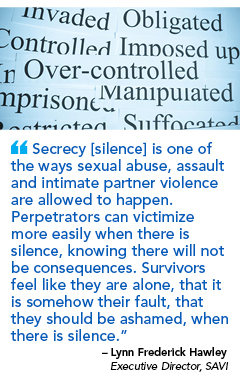 AM: What was your initial reaction when you were contacted by One World Symphony?
AM: What was your initial reaction when you were contacted by One World Symphony?
LFH: I was so thrilled! One of my original mentors in the field gave to me a quote by Margaret Mead: “Never doubt that a small group of thoughtful, committed citizens can change the world. Indeed, it is the only thing that ever has.” I fully embrace the philosophy that we can do so much more when we all work together, so I was incredibly excited to be invited to collaborate with One World Symphony in this way. Together we have the capacity to reach more people and be a catalyst for awareness. Also, the art of music is a fundamentally powerful way to engage people. I am honored that SAVI was asked to participate.
AM: A prevailing concern from this past election was the ill- and unfair treatment of women in our country. As the issue escalated, it was met on October 13, 2016 with Michelle Obama’s powerful speech, which didn’t just inventory injustices but served as a harbinger of change by empowering each of us to be the stewards for that change. What do you feel is the immediate impact of the First Lady’s words? Do you think there will be a lasting effect?
LFH: I think that Michelle Obama’s speech was powerful on a number of levels. My most immediate response was gratitude that she used her platform to send the clear message that misogyny, the minimizing of (or, perhaps worse, bragging about) sexual assault, and the engagement in these acts was somehow “normal” was not acceptable. The concept that there is just “locker room talk” and it is harmless is not true. When men dismiss and demean women in all-male spaces it is giving permission to treat women this way in public spaces, because it sends the message that women are somehow lesser. And Ms. Obama stated that clearly. But she also made sure to state that this harms not only women and girls but men and boys as well. On a staggeringly regular basis women and girls do experience the kinds of street harassment, sexual harassment, sexualization, and violence in their homes, jobs, and schools that Ms. Obama named, and this is possible when we give it justification (“boys will be boys, it’s just locker room talk, guy talk...”). But boys and men experience those kinds of violence as well in a climate that reinforces increasing one’s sense of power by demeaning others. It is also insulting to boys and men everywhere who do not treat women in this way nor talk about women in these terms to say that that is somehow the norm. I believe the immediate impact was to state in the moment, unequivocally and to a large audience, that we reject this minimization and we do not have to accept this as somehow just the way things are. It had to be counteracted in that way — so few other people were doing so.
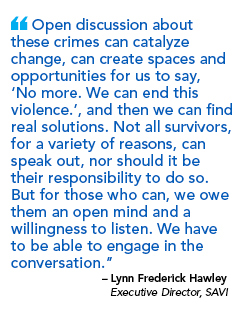 In terms of a lasting effect, it will remain to be seen. In my experience in this field, there are sometimes catalyzing moments that force change; sometimes there is an accumulation of experiences at which finally there is the last straw and movement occurs. But it all starts by people refusing to accept something as normal that is fundamentally wrong. In her statement she certainly reinforced that as a foundation from which we can all continue to build.
In terms of a lasting effect, it will remain to be seen. In my experience in this field, there are sometimes catalyzing moments that force change; sometimes there is an accumulation of experiences at which finally there is the last straw and movement occurs. But it all starts by people refusing to accept something as normal that is fundamentally wrong. In her statement she certainly reinforced that as a foundation from which we can all continue to build.
AM: Michelle Obama stated: “This is not something we can ignore. It’s not something we can just sweep under the rug.” Throughout history, sexual assault and violence were often considered topics that were taboo or too shameful for acknowledgement or discussion. This attitude was often governed by culture, generation, or even the media. As a result, issues like that of the euphemistic “comfort women” (sex slaves of the Japanese military) have only begun to surface in recent history. Surprisingly, these victims — many of them in their 80s and 90s — are often criticized for fighting for a resolution and challenged: “Can’t they just forget, leave it in the past, and move forward?” What do you think is the importance of having open discussion about sex abuse and crimes?
LFH: Secrecy [silence] is one of the ways sexual abuse, assault, and intimate partner violence are allowed to happen. Perpetrators can victimize more easily when there is silence, knowing there will not be consequences. Survivors feel like they are alone, that it is somehow their fault, that they should be ashamed, when there is silence. Shame is amplified for survivors and not aimed at abusers, where it belongs, when we are quiet. And the larger community can pretend that it is not a problem or is “minimal” if the extent and scope of the abuse and assault that occurs isn’t discussed openly. One cannot confront a problem if one is pretending it doesn’t exist — and sexual violence exists in a very big way in the United States.
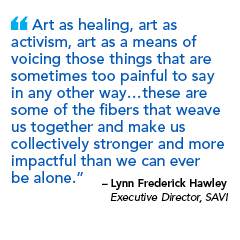 At SAVI we sometimes have a survivor call us 20 years after the assault happened and say “This is the first time I’ve told anyone.” They have carried that secret for decades and then maybe they read an article about sexual assault or heard another survivor speak at their church or watched a television show where someone was raped and told “It’s not your fault.” It is then that they feel like maybe they have a voice, maybe they can tell someone. So, in a very real way for survivors, speaking about sexual violence can open doors and contribute to their own healing. But on a larger scale, open discussion about these crimes can catalyze change, can create spaces and opportunities for us to say, “No more. We can end this violence,” and then we can find real solutions. Not all survivors, for a variety of reasons, can speak out, nor should it be their responsibility to do so. But for those who can, we owe them an open mind and a willingness to listen. We have to be able to engage in the conversation.
At SAVI we sometimes have a survivor call us 20 years after the assault happened and say “This is the first time I’ve told anyone.” They have carried that secret for decades and then maybe they read an article about sexual assault or heard another survivor speak at their church or watched a television show where someone was raped and told “It’s not your fault.” It is then that they feel like maybe they have a voice, maybe they can tell someone. So, in a very real way for survivors, speaking about sexual violence can open doors and contribute to their own healing. But on a larger scale, open discussion about these crimes can catalyze change, can create spaces and opportunities for us to say, “No more. We can end this violence,” and then we can find real solutions. Not all survivors, for a variety of reasons, can speak out, nor should it be their responsibility to do so. But for those who can, we owe them an open mind and a willingness to listen. We have to be able to engage in the conversation.
AM: Would you like to share anything related to SAVI or Defiant?
LFH: I would be remiss if I didn’t restate that SAVI is honored to have been asked to be the spotlighted organization for this performance. Art as healing, art as activism, art as a means of voicing those things that are sometimes too painful to say in any other way…these are some of the fibers that weave us together and make us collectively stronger and more powerful than we can ever be alone.
Amanda Burden and Jasleena Sahni from SAVI’s Training and Outreach programs will be on-site at Defiant to discuss the vital nature of their work and their role in serving the survivors of sexual assault in our local community. Meet SAVI, Amanda, and Jasleena on Sunday, January 22, 2017 at 8:00 p.m. in Chelsea.
For more information about Defiant >>
What would be the most crippling disability for a musician?
Ludwig van Beethoven (1770–1827) turned a devastating catastrophe into the human story of endurance, resilience and defiance. Not only did he go “high” — when most composers would have gone “low” in the face of such adversity — he soared higher and farther. He continues to inspire us across time and beyond boundaries.
At the turn of the 19th century, around the same time he began to grow deaf, Beethoven aspired to the ideals of the French Revolution. How was he going to defy an oppressive society and fight for a new world built on the foundations of liberté, égalité, et fraternité?
A moment of clarity ignited Beethoven’s self-transformation. He would no longer feed the ears of the privileged by writing music for their exclusive concerts in their affluent “living rooms,” salons, or palaces. Instead of minuets for the social events of the financial and political elite, he wrote scherzos — rugged, explosive dances. Instead of rebranding, he was revolutionizing himself, Western music, and perhaps even how one should experience art.
No longer interested in pretense, pleasantries, or worldly comforts, the composer found the courage to raise his voice. His compositions delved into the depths of the human soul. How can we not feel the world in turmoil in his music? Many of his personal works during the middle and late periods — such as Eroica symphony, Appassionata sonata, and Große Fuge — may have reflected his immense struggles, but also conveyed the spirit of the times: conflict, dissonance, contradiction.
Torment and discord abound in many of his mature works, but the second movement of his Seventh Symphony rages with perhaps his most sublime touch. It fosters mindfulness and the simple act of breathing. Its heart pulses in a desperate “Allegretto”, yet it serves as the “slow” movement. Dissonance. Contradiction. Instead of volcanic eruptions and jagged edges, the music flows like the Danube — with every idea or phrase interconnected, equal. Instead of focusing on a hierarchy of tones and structure, the inner power of the musical line emerges and is cultivated. Here, Beethoven sends us a clear message: art is not meant to just nourish the mind, it is meant to be heard by the heart.
Our contemporary culture encourages art to foster a rigorous and “liberatingly” unsentimental worldview. It tries to tell us that placing distance strengthens the emotional power.
Enough is enough.
During World War II, Charlie Chaplin appealed for a new world where tolerance, love, and kindness reigned. His impassioned speech from the 1940 film The Great Dictator resonates today more than ever. Seventy-six years later, with vocal gravitas, Michelle Obama delivered an ardent address condemning the abuse and harassment of women. Not only did her words crystallize feelings of outrage and hurt, her message went beyond the politics of the moment. It tapped far deeper into the heart of the issue — confronting our future as brothers and sisters and our shared humanity.
Would black artists like Langston Hughes, Margaret Allison Bonds, or Valerie Capers — the first blind composer to graduate from Juilliard — create art with a “liberatingly unsentimental” worldview and accept the intolerance and violence? Artists may not be able to prevent disasters, stop wars, or heal the sick, but they do have the power to inspire, uplift, and bring hope through their passion.
What would happen if each one of us adopted Beethoven’s approach with unassailable optimism and pathos? What if we each accordingly acted to transform ourselves first and helped build a world of hope and empathy... defy?
“This will be our reply to violence: to make music more intensely, more beautifully, and more devotedly than ever before.” – Leonard Bernstein
On behalf of One World Symphony staff and artists, we wish you a happy new year and looking forward to sharing our passion with all of you at Defiant on Sunday, January 22, 2017 at 8pm in NYC.
– Sung Jin Hong
Remembering Lloyd Paguia Arriola (August 6, 1972–July 17, 2016)
 New Yorkers are sometimes accused of being independent to the point of arrogance, of being self-focused and self-serving to the point of tunnel vision. Dr. Lloyd Paguia Arriola defied this stereotype.
New Yorkers are sometimes accused of being independent to the point of arrogance, of being self-focused and self-serving to the point of tunnel vision. Dr. Lloyd Paguia Arriola defied this stereotype.
 During the sweltering summer of 2004, Lloyd and I met for some bibimbap. While he was stirring in a healthy dose of gochujang, which he jokingly called the savory spice “Korean ketchup,” he didn’t seem his normal energetic self. He was concerned regarding the upcoming presidential election, and he suggested that we leave America and move to Germany or Austria and begin something together. However, One World Symphony was about to launch its fourth consecutive season without a website, any social media, or feature reviews. Returning to Europe was not an option. I stressed that he was more a New Yorker than me — the very best kind! Instead of “flight,” I reminded him to continue to fight and continue to sow his seeds in our home, even during the age of Iraq War and unequal democracy.
During the sweltering summer of 2004, Lloyd and I met for some bibimbap. While he was stirring in a healthy dose of gochujang, which he jokingly called the savory spice “Korean ketchup,” he didn’t seem his normal energetic self. He was concerned regarding the upcoming presidential election, and he suggested that we leave America and move to Germany or Austria and begin something together. However, One World Symphony was about to launch its fourth consecutive season without a website, any social media, or feature reviews. Returning to Europe was not an option. I stressed that he was more a New Yorker than me — the very best kind! Instead of “flight,” I reminded him to continue to fight and continue to sow his seeds in our home, even during the age of Iraq War and unequal democracy.
Lloyd fought for two decades in New York City not by fiercely focusing on himself, but by always lifting and empowering others around him through his magnanimous spirit. Even if he had tempestuous political disagreements with his closest friends, he always gave everything to the music and to his tribe of collaborators.
If artists are judged by how they treated their neighbors, he was one of the greatest I have ever known. He continues to teach us about life and true living with passion and purpose. He was more than a mensch. He was a doctor who healed through the power of music and laughter, a humanitarian committed to social justice and building bridges instead of walls, and a devoted friend and brother who made everyone he touched feel special, cared for, and loved.
Lloyd has inspired me then. He still does today.
Concert photos, above and right: (Thank you to my father-in-law Ron Metzinger for capturing the moment): Lloyd Arriola was a featured soloist in Gershwin's Rhapsody in Blue at One World Symphony's soldout debut at NYC's historic Town Hall on March 2006. He gave a passionate performance with a broken finger. Lloyd collaborated with One World Symphony in numerous auditions and productions including, TimeOut Critic's Pick program as the soloist in Ravel's Piano Concerto in G.
Lloyd and I shared many discussions on various topics, including current events, politics, arts, anniversaries, etc... Here's his email on One World Symphony's programming:
Subject: Age of Anxiety — A Season of Journeys
Sung Jin — Great to talk to you. Say hi to Adrienne for me, too!
Oh-kay! Now, as for the programs, I think the “Mysteries and Mystics” season works well, but why not this...
Call it “Journeys,” perhaps. The mysteries aspect is nice, but to combine both of the best aspects of the two seasons as you see it is more appropriate and approachable for your stalwarts, and more importantly, for those who are coming aboard. You have a great project with OWS — tell people with the inclination to come aboard the OWS that the orchestra does not work without their loyalists, and with new folks — and then this is when you take them on the journey, both mystical and geographical.
The program choices are great, I think. Especially the one with Lloyd Paguia Arriola, piano soloist in Bernstein's “Age of Anxiety.”
SO, when are we doing Brahms Piano Concerto No. 1????? Messiaen Turangalia, Liszt Totentanz, your Concerto?
Be well — Lloyd
Lloyd Arriola’s Biography (unedited, from his official website):
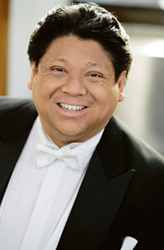 A dynamic and powerful recitalist, a sensitive accompanist and an intelligent interpreter of contemporary music, Lloyd Arriola is a highly experienced pianist and conductor who has worked in a variety of musical genres on an international scale. Lloyd has appeared on the stage of New York’s Town Hall in Gershwin’s Rhapsody in Blue and with the One World Symphony of New York he performed Ravel’s Piano Concerto in G in another much-lauded performance. He has performed as an accompanist for distinguished singers such as Lucine Amara, among others. He has conducted West Side Story in the Semper Oper Dresden and Matsumoto Performing Arts Center of Japan, and the national tour of Philip David Stern’s Scrooge –The Musical. Lloyd can also be heard on the recording of Allen and Wallace Shawn’s “play-opera” The Music Teacher, on Bridge Records. And, as an orchestral pianist, Lloyd has worked with such important conductors as Zubin Mehta, Kurt Masur, Jahja Ling, Richard Buckley, Joel Smirnoff, and many others.
A dynamic and powerful recitalist, a sensitive accompanist and an intelligent interpreter of contemporary music, Lloyd Arriola is a highly experienced pianist and conductor who has worked in a variety of musical genres on an international scale. Lloyd has appeared on the stage of New York’s Town Hall in Gershwin’s Rhapsody in Blue and with the One World Symphony of New York he performed Ravel’s Piano Concerto in G in another much-lauded performance. He has performed as an accompanist for distinguished singers such as Lucine Amara, among others. He has conducted West Side Story in the Semper Oper Dresden and Matsumoto Performing Arts Center of Japan, and the national tour of Philip David Stern’s Scrooge –The Musical. Lloyd can also be heard on the recording of Allen and Wallace Shawn’s “play-opera” The Music Teacher, on Bridge Records. And, as an orchestral pianist, Lloyd has worked with such important conductors as Zubin Mehta, Kurt Masur, Jahja Ling, Richard Buckley, Joel Smirnoff, and many others.
As a teenager growing up in San Francisco, California, Lloyd began his career as a conductor for a local performance of Gian Carlo Menotti’s Amelia Goes to the Ball. He has continued to music direct and conduct operas ranging from Julius Caesar to La Bohème to La Serva Padrona and I Can’t Stand Wagner. Recently Lloyd was one of the pianists for the world premiere of the two piano version of William Bolcom’s opera A View from the Bridge with Vertical Player Repertory theatre. Lloyd continues to conduct and play works of the American musical theatre including Cabaret, Gypsy, Hair, Jesus Christ Superstar, Little Shop of Horrors, The Fantasticks, and dozens of others.
Lloyd Arriola studied at The Peabody Institute and at The Juilliard School, where he received his training from Yoheved Kaplinsky. Lloyd received his Doctorate of Musical Arts in Piano from Juilliard in 2002, the first person of Filipino descent to receive his doctoral degree from that institution. He currently serves on the faculty of the Professional Performing Arts High School as their Pianist-in-Residence, and the pianist for the Manhattan Girls Chorus. He is a former faculty member of Sarah Lawrence College, William Paterson University, and Montclair State University. Lloyd lives in New York City.
For Tickets & Information about the Lloyd Arriola Tribute & Fellowship on August 28th >
Is The Force strong with these ten composers?
The Force captivated me before I could even speak a word of English. When my family immigrated to the United States in time for the premiere of Return of the Jedi, I was spellbound. I could not stop singing the tunes from John Williams' soaring score at elementary school. My love affair was shared through One World Symphony’s live performances of the music from Star Wars at my wedding to Adrienne Metzinger and at NYC’s Town Hall.
Rekindle the spirit of the galaxy far, far away to discover if the Force is strong between these ten composers and their Star Wars doppelgängers. May the Force be with you...
Han Solo Irresistible. Daring and diverse with endless swagger. A serial risk-taker, but you would probably want him on your side in adventures and productions. "Scoundrel? Scoundrel? I like the sound of that."– Han Leonard Bernstein (1918 – 1990) "If you're a good composer, you steal good steals."– Bernstein |
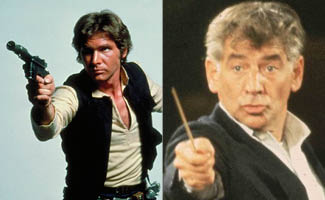 |
Princess/General Leia Organa A rebel during unspeakable purges, challenger of the totalitarian state. The stylish sharp-tongued leader inspired many to fight for justice and make a difference in the world. "I'd just as soon kiss a Wookie." – Leia Dmitri Shostakovich (1906 – 1975) "If they (Stalin and his secret police) cut off both hands, I will compose music anyway holding the pen in my teeth." – Shostakovich | 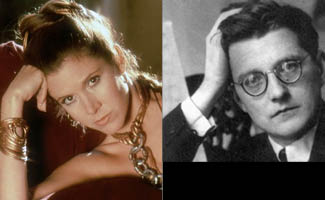 |
Yoda A visionary and revered spiritual guide, the Jedi Master teaches that inner peace comes through compassion and the release of self, not the exaltation of self. "Do or do not, there is no try." – Yoda Hildegard von Bingen (1098 – 1179) "Love abounds in all things, excels from the depths to beyond the stars." – Hildegard von Bingen | 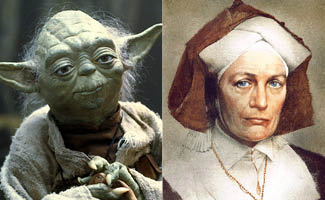 |
Darth Vader A child prodigy of supernatural origins, Anakin was prophesied to bring balance to the Force. Did Borderline Personality Disorder and abandonment/ daddy issues make him vulnerable to be seduced by the dark side? “I find your lack of faith disturbing.” – Vader Wolfgang Amadeus Mozart (1756 – 1791) "I wanted them to beg me. And so they did. I gave a concert." – Mozart | 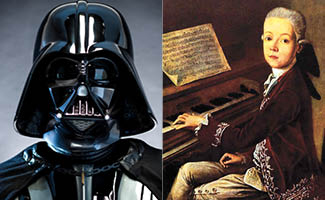 |
Luke Skywalker Born in a galaxy of wars and revolution, this late bloomer overcame struggles and failures with unwavering tenacity. By bearing great inner strength and believing in something larger than himself, he never shied away from a fight, solitude, or insurmountable odds. "But how am I to know the good side from the bad?" – Luke Ludwig van Beethoven (1770 – 1827) "Love demands everything and completely, that is how it is for me with you, and for you with me." – Beethoven to his "Immortal Beloved" | 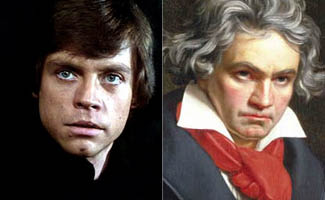 |
Obi-Wan Kenobi This nurturing mentor instills the courage to try, even at the risk of failure. Wise and selfless, he champions those who are dearest to him, so they may fulfill their destiny. "If you strike me down, I will become more powerful than you can possibly imagine." – Kenobi Clara Schumann (1819 – 1896) "My innermost soul whispers always to you.”– Clara Schumann | 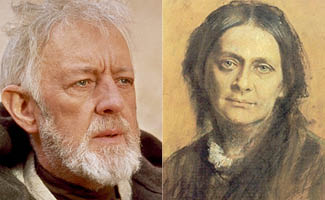 |
R2-D2 An ideal collaborator and improvisor, without an inkling of ego, he frequently proves his resourcefulness, loyalty, and cleverness. Whether he’s your cohort or your copilot, his melodic and lively voice is always welcome. "Beep beep dooh wop pop bibimbop..." – R2 George Gershwin (1898 – 1937) "Life is a lot like jazz, it's best when you improvise." – George Gershwin | 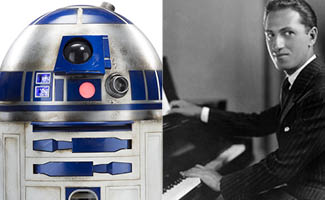 |
Chewbacca Hairy. Respected for his power and gravitas, this strong silent type allows his work to speak for him. Loyal, fierce, and tender-hearted. "RAWRgFAHRERgKRAFTrr" – Chewiee Johannes Brahms (1833 – 1897) "One cannot speak one's gratitude, one can only prove it." – Brahms | 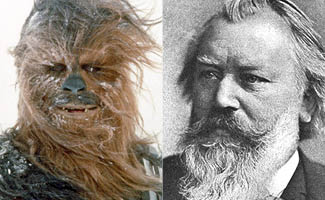 |
Emperor Palpatine Obsessed in discovering the secret to eternal life, the Sith achieved supreme power through seduction and manipulation of human mind and emotions. A god complex? "Once more the Sith will rule the galaxy, and we shall have peace." – Palpatine Alexander Scriabin (1872 – 1915) "I am a moment illuminating eternity... I am affirmation...I am ecstasy... I am God!" – Scriabin | 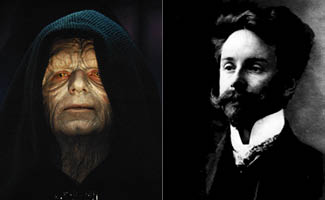 |
Rey* The ultimate DIY Swiss army knife, who can fix and fly anything at light speed. She possesses a keen sense of resolve and the natural instincts to harness the Force without ego. Does she have the potential to be one of the most sublime and balanced Jedi ever? "I am no one." – Rey Johann Sebastian Bach (1685 – 1750) "Love is not blind - it simply enables one to see things others fail to see." – J.S. Bach | 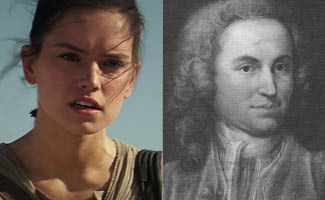 |
*Who is Rey?
The etymology of "rey" and "rei" has numerous meanings ("king" in Spanish, "my shepherd" in Hebrew). Is Rey Han and Leia's daughter, Luke's daughter, Kenobi's grand daughter, or the child of Midi-chlorians? Since she's depicted as the natural, could she be both the grand daughter of Kenobi and daughter of Luke? Similar to Beethoven, could Kenobi and Luke have kept their respective "immortal beloved" a secret?
– Sung Jin Hong
Thanking all Fannibals and Music Lovers!
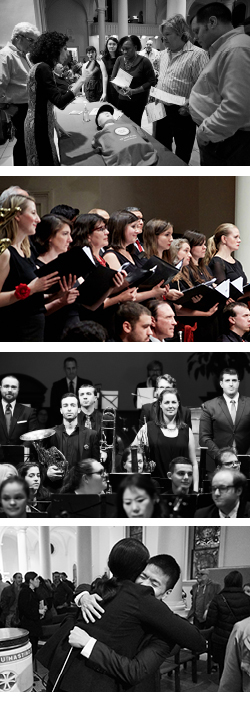 Immediately after the resonance of Hannibal’s final chord, I was moved with what we shared together:
Immediately after the resonance of Hannibal’s final chord, I was moved with what we shared together:
silence
Standing in the intense stillness for what felt like eternity with all our musicians and guests at the premiere may have been one of the more poignant experiences of the evening. This suspended moment of time allowed an unexpected and intimate communion for our performing artists and attentive guests. Thank you!
After our joint heightened state of awareness, it was pure joy meeting many creative Fannibals from all over the country. One of the guests whom I had the pleasure of greeting and hugging after the show was my anesthesiologist for my emergency foot surgery from earlier in the week. It was a pleasant surprise to discover that she may be a Fannibal herself!
Surprises are the stuff of life, and an unanticipated medical emergency occurred to one of our violinists earlier that day. At the 11th hour — just about 15 minutes before the show — it wasn’t looking promising. We were fortunate enough to have THE doctor in the house: cardiologist Dr. Steven Markowitz, who also helped me expand my research on the heart rhythms and murmurs that were incorporated into Hannibal. He generously attended to our violinist, and counseled and comforted her. He was a hero behind the scenes, thoughtfully taking care our musician. In turn, we were amazed and grateful to our violinist for persevering and performing at the premiere!
We at One World Symphony would like to take this moment to thank Dr. Steven Markowitz and Jody Scopa Goldman of the Heart Institute at New York Presbyterian Weill Cornell for generously teaching our guests Hands-Only CPR, a technique that can be a life-saving difference for someone who is experiencing a cardiac arrest.
It was an honor and a great pleasure to make music with all our artists. At the soundcheck around 90 minutes before the premiere, all seventy musicians (soloists, Concertus, and Symphony), “wearing blotches of fiery red lipstick, stilettos and neckties,” were in their places, focused, and embraced the moment and opportunity to share our passion with each other and our world premiere guests.
Thank you very much to all our musicians for bringing the blueprint to life and to all of our guests who attended the premiere.
Hannibal photos by Jaka Vinšek >>
Fannibals reviews/buzz on social media >>
Bryan Fuller tweets about the world premiere of Hannibal (2015)
The creator of NBC's hit drama series Hannibal, Bryan Fuller, tweeted about tonight — One World Symphony's world premiere of Hannibal (2015)!
THIS SOUNDS AMAZING!!! 5 Questions With The 'Hannibal' Opera Composer/Conductor Sung Jin Hong https://t.co/DZ2TGqaz7A
— Bryan Fuller (@BryanFuller) October 25, 2015Bryan Fuller's tweet is referring to the feature interview by Hannibal Fannibal's Jess Goodwin. She wrote:
"Bryan Fuller’s vision of Hannibal might be on pause right now, but Fannibals are keeping it alive and well not only in our hearts (and social media), but, in the case of One World Symphony conductor Sung Jin Hong, on the stage as well. In what promises to be an adaptation worthy of Hannibal Lecter’s refined tastes, Hong has taken the series and twisted it into his latest “operasode.”
Please read the complete feature interview here. >>
The Daily Dot Feature Interview and Meet the Hannibal Cast
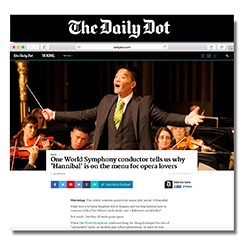 Aja Romano of The Daily Dot recently previewed One World Symphony's production of Hannibal (2015). I learned that beyond being a passionate writer and journalist, she studied voice at the prestigious Indiana University. Check out her absorbing journal here >>
Aja Romano of The Daily Dot recently previewed One World Symphony's production of Hannibal (2015). I learned that beyond being a passionate writer and journalist, she studied voice at the prestigious Indiana University. Check out her absorbing journal here >>
When she interviewed me, we discussed Hannibal and explored overtones of genderqueerness, mad scenes, audience engagement, Operasodes and our current zeitgeist:
"When [Sung Jin] developed the idea of 'operasodes' based on modern pop culture phenomena, he knew he was building on a vast cultural tradition of remixing and adapting works across mediums... [But after] Breaking Bad and Game of Thrones, he found himself the subject of major profiles in the Guardian and Esquire. It was clear he'd hit paydirt on an idea that spoke to the community...and helped usher [One World Symphony] into a new phase of audience interactivity."
She left me with a question to ponder: "Is performing powerful music enough to resonate and engage with our community?" Please read all of Aja's thoughtful interview here >>
I'd also like to take this chance to introduce you to our Hannibal cast. These vocal artists—all of them part of the One World Symphony community—committed to the project without seeing a single note of music in advance. Their level of trust in me and their patience is immensely appreciated.
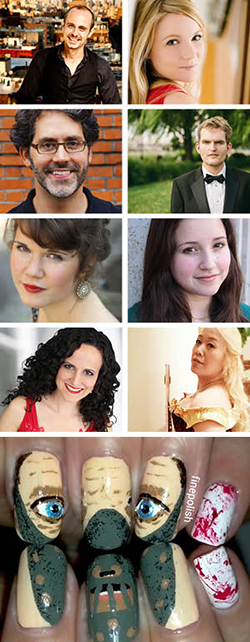 So who the FACH will sing the title role? As Aja described it in the feature interview: "Hong made a number of startling musical choices for this opera. Most notably he cast countertenor Nicholas Tamagna as Hannibal, bringing the character's genderqueer and omnisexual overtones to the forefront" by harnessing the enigmatic qualities of this rare voice part. Nicholas and I had the great pleasure of collaborating in Mahler's "Ich bin der Welt abandon gekommen" in The Wayfarer. At the world premiere this Sunday, October 25th, you can judge for yourself if casting a countertenor was a convincing choice for Hannibal.
So who the FACH will sing the title role? As Aja described it in the feature interview: "Hong made a number of startling musical choices for this opera. Most notably he cast countertenor Nicholas Tamagna as Hannibal, bringing the character's genderqueer and omnisexual overtones to the forefront" by harnessing the enigmatic qualities of this rare voice part. Nicholas and I had the great pleasure of collaborating in Mahler's "Ich bin der Welt abandon gekommen" in The Wayfarer. At the world premiere this Sunday, October 25th, you can judge for yourself if casting a countertenor was a convincing choice for Hannibal.
Tenor, copywriter and editor Ransom Bruce will be performing the role of FBI profiler Will Graham. Ransom was electrifying as Bob Boles in one of One World Symphony's most successful productions, the complete, uncut Peter Grimes by Benjamin Britten. His "method acting" was immediately apparent here, as he used his FBI-level sleuthing skills to catch a few discrepancies between my original manuscript and the final printed score!
Soprano, dancer and yogini Marie Putko, who made her One World debut as Susanna in our New Girls Operasode, will bring life to the role of Abigail Hobbs. I wrestled with which principal character would sing my first operatic mad scene. My decision went to the unassuming, yet not-to-be-underestimated, character of Abigail. It was a lot of fun capturing her innocence, grappling with her descent into hysteria, and eventually empowering her. Does this monodrama reflect any influences from the quintessential mad scene in Donizetti's Lucia di Lammermoor? I hope you'll come and tell me what you think.
Soprano, President of Opus Strategy, and mother of two boys Laura Farmer will sing "Pie Jesu" from Fauré's Requiem (the Sanctus and Agnus Dei are also on the program, featuring One World Concertus). Laura recently performed as Marie Schrader in our sold-out world premiere of Breaking Bad — Ozymandias and as Elettra in the Games of Thrones Operasode. I'll never forget the first time we met. Laura arrived as a walk-in at one of our marathon auditions. She waited for at least two hours, somehow remained vocally fresh, and won the heated competition for the role of Frasquita in our acclaimed Carmen.
Harpist Kristi Shade has been One World's principal harpist since we first collaborated on Peter Grimes. Ever since I started putting pencil to staff paper, I've learned that instrumentalists are often a composer's best friend, as they know their instruments so much more intimately. Kristi has been an invaluable guide in showing me the expansive possibilities of this exquisite instrument. Our guests are guaranteed a sublime treat with Kristi's rendition of the Aria from Johann Sebastian Bach's Goldberg Variations.
I invite you to get to know the rest of our featured artists as well: Jane Albert (Mischa Lecter in Hannibal), Finnish pianist Markus Kaitila (Saariaho), and principal flutist and nail artist Chrissy Fong here >>
Compositions are blueprints. I am immensely grateful to all our dedicated and passionate artists, Concertus, One World Symphony and all of the the world premiere audience members who will bring this new blueprint to life. See you on October 25!
INTERVIEW WITH CARDIOLOGIST DR. STEVEN MARKOWITZ
“In his mind a silver pendulum swung in the darkness. He waited until the pendulum was still...” — Red Dragon, Thomas Harris
Growing up with very humble beginnings and few resources, my mother instilled in my sister and me to always feel “bool-sahng-heh” (불쌍해 – Korean for sympathy) for others.
The re-occurring themes of sympathy, imagining, hypothesizing, perspective-taking are explored in the paradox of the FBI profiler Will Graham in Harris’s Red Dragon and lushly developed in Fuller’s Hannibal. Graham’s unique gift — pure empathy (7) — was also his curse. His heightened ability to immerse himself in not only the victims, but also the psychopaths he was profiling, made us ask: is empathy always good, or can it be dangerous? Was his gift clouding his judgment and driving him away from the basic human sense of justice and morality? Graham’s self-destructive path multiplied when he sought psychoanalytic treatment from Dr. Lecter, in Fuller’s drama. Would Graham have been in better care under the humanistic approach of Dr. Viktor Frankl instead?(8)
How is the “silver pendulum” swinging approached in Hannibal (2015)? Besides the natural use of polychords and polytonality to blur or even suspend the sense of a tonal or moral center, how do I depict Will Graham’s fatal gift?
My mother’s influence haunted me again, and I asked myself, “What is bool-sahng-heh?” I believe that she was asking us to listen to each other’s hearts. This eureka moment during the creative process inspired me to investigate and study the human heart and its various rhythms and murmurs. The more I researched, the more I became fascinated and even obsessed.
Did you know that there is a heart murmur that is considered “pathological?” So, instead of literally depicting the swinging sound of the silver pendulum in the music drama, I decided that Will should hear not only his, but also the victims’ and pyschopaths’ heart rhythms and murmurs. What happens when their pulsating hearts intertwine?(9)
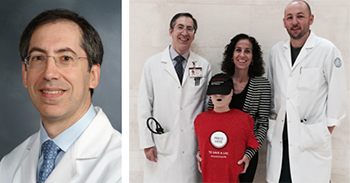
Left Photo: Cardiologist Dr. Steven Markowitz. Right Photo (left to right): Cardiologist Dr. Steven Markowitz,“little Albert,” Program Manager Jody Scopa Goldman, Program Coordinator Dr. James Horowitz
Before I decided to incorporate my findings of heart rhythms and murmurs in Hannibal, I wanted a professional to confirm and help expand my research. I reached out to some of the most respected cardiologists in the country, and karma struck immediately. Dr. Steven Markowitz at New York-Presbyterian Weill Cornell responded and invited me to his office. Thinking our meeting might last only 15 minutes, I was pleasantly surprised our our first date lasted around an hour and a half. It was evident that he was genuinely interested and we shared similar passions: music and the heart.
While we were exchanging ideas and exploring possible collaborations, he kindly offered to ask Jody Scopa Goldman, Dr. James Horowitz, and their staff from the Heart Institute at New York-Presbyterian Weill Cornell Medical Center to teach HandsOnly CPR at the premiere — a technique that can be a life-saving difference for someone who is experiencing a cardiac arrest.
We at One World Symphony are grateful and honored to have Dr. Steven Markowitz and the dedicated staff at New York-Presbyterian Weill Cornell’s Heart Institute collaborate with us to help save lives. Thank you very much, Steve, and we looking forward to seeing you and your staff at the world premiere of Hannibal on October 25.
Dr. Steve Markowitz, who studied at Harvard Medical School, is an attending physician at New York-Presbyterian Hospital and Professor of Medicine at Weill Cornell Medical College, Cornell University. “As a cardiologist who specializes in heart rhythm abnormalities, I have witnessed dramatic changes in our understanding of arrhythmias and in treatment possibilities to improve health and longevity of our patients.” Please get to know his amazing work and his dedication to his patients here.
Dr. Markowitz generously consented to sit for an interview for our audiences.
Sung Jin Hong: What or who inspired you to become a cardiologist? Was there a specific event or individual?
Dr. Steven Markowitz: During my fourth year of medical school, my father experienced a heart attack, coincidentally while I was rotating on a cardiology elective. I witnessed the capabilities but also the limitations of what cardiac care could accomplish at that time. I suppose this experience influenced — perhaps subliminally — my career direction to advance the care of cardiac patients.
When you think of the natural processes that govern heart function, it is fascinating and humbling. The heart beats around 100,000 times per day, each beat generated by spontaneous processes within the heart that allow an electrical impulse to be generated and cause the muscle to contract. This interest in the electrical properties of the heart led to my choice to treat disorders of cardiac rhythm.
SJH: Can you please tell us more about New York-Presbyterian Weill Cornell Center’s Heart Institute and how it actively serves our community?
SM: The Heart Institute at New York-Presbyterian Weill Cornell is committed to offering our patients and the community the most advanced cardiac care and effective prevention of cardiac disease, in a caring and compassionate environment. We have a variety of community outreach activities, which include educational talks for the public on heart health and cardiac surgery, teaching CPR, and heart-healthy activities like Zumba.
SJH: What was your initial reaction when a composer contacted you to discuss the use of heartbeat rhythms and murmurs such as systolic and diastolic murmurs and ventricular and atrial gallops, for a Hannibal opera?
SM: I must admit that I was surprised and intrigued. I was aware that some composers had incorporated heart rhythms into their music, including some well-known concert pieces. It would be interesting to see how this is incorporated into the creative process. I was excited to meet a composer and bridge the cultures of medicine and music.
SJH: One of your favorite classes while you were a student at Harvard University was music history. What was so memorable about the class?
SM: This class gave me — a science major who was most comfortable with quantitative subjects — a capacity to listen to compositions and appreciate their forms and their places in musical history. I remember spending time in the library, listening to music on headphones, immersed in these masterful works that opened new horizons for me.
SJH: You fondly mentioned the cardiologist guru Dr. W. Proctor Harvey(10). Dr. Harvey encouraged his students and colleagues to train their own listening skills — for example, by playing Beethoven’s Ninth Symphony and asking them to listen for specific rhythms — rather than simply relying on technology. Do you think the cardiology field would benefit from an application of the “human ears over machines” approach?
SM: Just as young generations of doctors have lost skills in auscultation, so have many lost skills of listening to their patients. Regretfully, our health care system exerts numerous pressures on physicians, which detract from the amount and quality of time they spend with patients. Certainly, young cardiologists would benefit from honing their skills of listening to hearts and listening to patients.
You would be interested to know that Cornell sponsors a Music and Medicine initiative, a program that permits medical students who are gifted to merge their musical and medical experiences.
SJH: What are you most looking forward to experiencing at Hannibal?
SM: I am particularly interested in hearing how you chose to depict heart rhythms and sounds in your music. And I do hope not to develop an arrhythmia while listening to the more dramatic passages!
SJH: Would you like to share or comment on anything else?
SM: It has been a pleasure collaborating with you, and I am eagerly anticipating the premiere performance.
Footnotes
7. The Victorian novelist and journalist George Eliot eloquently discussed empathy without the use of the word: “The greatest benefit we owe to artist is the extension of our sympathies... Art is the nearest thing to life; it is a mode of amplifying experience and extending our contact with our fellow-men beyond the bounds of our personal lot.” Her description reminds me of the tender and transformative experience when Cameron from Ferris Bueller’s Day Off focuses on George Seurat’s A Sunday Afternoon on the Island of La Grande Jatte. For the first time, the audience can empathize with the misunderstood Cameron during this poignant moment of refuge.
8. One of my favorite classes while a student in Vienna was a philosophy course taught by Dr. Doris Lechleitner. She introduced me to Dr. Viktor Frankl’s therapeutic practice of logotherapy — the belief that it is the striving to find a meaning in one’s life that is the primary, most powerful motivating and driving force — and his inspiring story of survival and empathy even during the unimaginable horrors in Nazi concentration camps.
9. At the Norton Lectures at Harvard University, Leonard Bernstein may have been the first person to say that in the opening pages of Gustav Mahler’s Ninth Symphony, the composer depicted his own irregular heart rhythm, specifically played by the cellos and fourth horn. As a conductor analyzing the opening pages of Mahler’s Ninth, I hear the sextuplet viola line starting on measure 5 as a signal of an abnormal heart murmur, not rhythm. Mahler’s touch of having the sextuplet violas play on the “weaker” pulse foreshadows the inevitable turbulent blood flow. Like Bernstein, I’m an emotional wreck when I immerse myself with this symphony as a listener or a conductor.
10. Dr. W. Proctor Harvey (1918–2007) appeared to be a Jedi among cardiologists. Here’s an article on his approach and Beethoven’s Ninth.
WHICH FACH WILL SING HANNIBAL LECTER?
The score to Hannibal (2015) is complete. It took longer to compose than I expected. Alex Diamond of CUNY TV empathized and informed me that the sophomore novel is always the toughest. I would agree; however, I don’t believe I’ve written my first novel yet.
Two main hurdles had to be overcome to even begin Hannibal:
First, they say your “first” may be the toughest to get over. The affair lasted only three months, full of many long nights together burning the midnight oil. We were in sync, she got me, she hypnotized right from the pilot: Breaking Bad. Writing my first music drama, Breaking Bad — Ozymandias was an all-consuming and passionate affair, but then it was over. What do you do after the breakup of such a torrid relationship: see a psychiatrist, replace it with something else, or collapse into the pain of loneliness, lost in an aching hole of absence, the emptiness within?
How about all of the above? Enter Thomas Harris’s Red Dragon and Bryan Fuller’s Hannibal. While Harris’s psychological thriller ventured into the darkest places and most visceral fears, Fuller’s drama carved out a niche for itself in the serial killer genre — not only through sensual and hallucinogenic horror, but by focusing on the debilitating journey of mental illness. Their works inspired me to address profound mental disorders, traumas, complex and forbidden love, and the deep longing for empathy and intimacy through music.
Now that my imaginative canvas was lit on fire, I was faced with my next challenge. Where do I even begin? How do you tackle — in just 45 to 50 minutes of music(1) — a character and a narrative that spans four novels, five films, and 39 television episodes? Which characters should be developed, nurtured, made sympathetic?(2)There was almost too much inspiration at hand — too many fascinating storylines within the Hannibal Lecter universe. The only thing I could do was focus on the complex character relationships that moved me and cultivate their intricate narratives and controversial transformations.
During the creative process of Hannibal, I leaned towards the side of the cerebral, curious, probing. I wrestled with some of the following questions:(3)
- How did Lecter transform into a monster? Does he ever feel remorseful or guilty in any way? Is he human?
- How far can I explore themes of folie à deux(4), intense psychological traumas, and forbidden love between the two protagonists in Fuller’s drama?
- Should I incorporate Lecter’s favorite piece, Bach’s Goldberg Variations, in the music drama? If so, how?(5)
- If I commit to composing my first operatic Mad Scene in Hannibal, who should sing this monodrama? Lecter, Graham, Dolarhyde, Chilton, Verger...?
- Instead of imitating the swinging sound of the silver pendulum, how can I find my own unique voice to represent Will Graham’s rare gift of pure empathy?
- Similar to Harris’s Red Dragon, should I incorporate William Blake’s Songs of Innocence and Songs of Experience?
- Lastly, which fach(6) will be singing the title role? Could a countertenor bring a delicate union of terror and the sublime, the female and male?
In the subsequent blogs, I’m looking forward to introducing our dedicated cast, discussing a unique partnership with New York-Presbyterian Weill Cornell Medical Center’s Heart Institute and share how I addressed these questions in Hannibal (2015).
Footnotes
1. The libretto alone took more than three months to excavate, and my original sketch had around 80 minutes of music.
2. In Harris’s Red Dragon, the reader may feel more indifferent towards Will Graham compared to Fuller’s drama. Perhaps this was intentional, as Harris planned to have the readers feel more sympathy towards his next protagonist in The Silence of the Lambs: Clarice Starling.
3. The curious side motivated me to investigate real heartbeat rhythms and murmurs for Hannibal. My research was confirmed by cardiologist Dr. Steven Markowitz. We decided to continue to collaborate by having his New York-Presbyterian/Weill Cornell Medical Center’s Heart Institute partner with One World Symphony at Hannibal on October 25. In one of my upcoming blog entries, I’ll be sharing some discoveries from the research and the fascinating meeting with Dr. Markowitz.
4. Folie à deux in French means a madness shared by two.
5. In the film The Silence of the Lambs, Lecter celebrates with Bach’s Goldberg Variations immediately after one of his monstrous crimes.
6. Fach in German means subject; in this context it refers to sense of vocal specialization or a method of classifying singers.
HANNIBAL: WORLD PREMIERE SERIAL OPERA (50 sec Teaser Trailer)
(Trouble viewing this video? Watch it here.)
Teaser Trailer: Hannibal, A World Premiere Serial Opera
Original Composition by Sung Jin Hong
Performed by One World Symphony on unplugged acoustical instruments
Composer-Conductor: Sung Jin Hong
50 second Video: Adrienne Metzinger
THE COOK, THE COMPOSER AND HIS CAT
HEISENBERG'S RESURRECTION
Thank you to all our fans who have expressed their enthusiasm to experience Breaking Bad — Ozymandias again. Heisenberg will be resurrected for one more performance only in One World Symphony’s season finale on Monday, May 19. Details, tickets and the new video are here.
Breaking Bad — Ozymandias 2.0
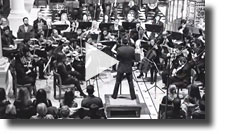 After the world premiere performances of Breaking Bad — Ozymandias in January 2014, I decided to allow the score and the experience to settle and breathe. Similar to how Heisenberg was not only still alive and well in the beginning of the final season, he returned with a whole new depth and darkness. To reflect this, instead of having three sopranos as the principal female vocalists (Skyler, Marie, and Jane), I have written for one soprano as Jane and two mezzos: the sisters Skyler and Marie.
After the world premiere performances of Breaking Bad — Ozymandias in January 2014, I decided to allow the score and the experience to settle and breathe. Similar to how Heisenberg was not only still alive and well in the beginning of the final season, he returned with a whole new depth and darkness. To reflect this, instead of having three sopranos as the principal female vocalists (Skyler, Marie, and Jane), I have written for one soprano as Jane and two mezzos: the sisters Skyler and Marie.
Returning as Heisenberg/Ozymandias, the versatile José Pietri-Coimbre anchors a new vocal cast in the revised version of Breaking Bad — Ozymandias. Please feel free to get to know our new cast here.
Libera: Last Love from Ukraine, Barefoot in Venezuela...
The season finale’s theme will remain Libera, which will include music from Beethoven’s historical epic music drama Egmont and New York premiere of Ukrainian composer Valentin Silvestrov’s Last Love. The news reported that many Crimeans legitimately do want to be part of Russia, but many Ukrainians, including Mr. Silvestrov, have been protesting against Russian invasion.
Our own hemisphere is sadly no stranger to upheaval. One World Symphony will also perform music by Venezuelan composer Antonio Lauro to support the protestors and barefoot students fighting for justice and tolerance — and even toilet paper — in that South American country. Inspired by an article from Newsweek on April 17, 2014, One World Symphony will perform Barefoot in Venezuela, arrangements from Mr. Lauro’s music for guitar.
FreeStylin! Taking Inspiration from Jimmy Fallon and The Roots
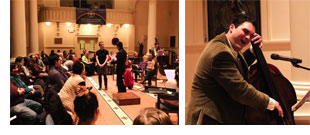 In One World Symphony’s recent show Spring Break, we integrated FreeStylin’. Led by our principal double bassist Justin Lee, One World Symphony made up songs on the spot with information compiled by each audience member’s interview. The songs — in the style of the audience member’s choosing (reggae and progressive rock) — were fun improvisation tests for the “band.” Check out One World Symphony’s upcoming shows for more Freestylin’ and interaction with its audiences. Check out Freestylin’ photos here.
In One World Symphony’s recent show Spring Break, we integrated FreeStylin’. Led by our principal double bassist Justin Lee, One World Symphony made up songs on the spot with information compiled by each audience member’s interview. The songs — in the style of the audience member’s choosing (reggae and progressive rock) — were fun improvisation tests for the “band.” Check out One World Symphony’s upcoming shows for more Freestylin’ and interaction with its audiences. Check out Freestylin’ photos here.
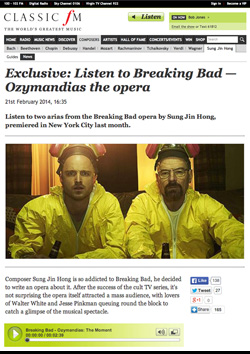 CLASSIC FM EXCLUSIVE of BREAKING BAD— OZYMANDIAS
CLASSIC FM EXCLUSIVE of BREAKING BAD— OZYMANDIAS
Listen to the live unedited world premiere performance of Breaking Bad — Ozymandias at “the U.K.’s favourite classical station.” We at One World Symphony are grateful that Classic FM’s Mel Spencer asked usto share a recording of the world premiere performance.
Who watched Jimmy Fallon’s first Tonight Show broadcast from NYC? His very first opening monologue offered appreciation, earnest, charm, humor, and lots of honest emotion. Besides being a gracious host, he’s definitely not afraid to share his feelings and show his emotions. With an endearing and sweet tone, he shared the Tonight Show’s VISION: “My goal is to make you laugh, put a smile on your face... so you may go to bed with a smile on your face... so you may live a longer life.”
His “vision” re-energized me to continue to pursue how One World Symphony can better fulfill its VISION. In Jimmy’s vernacular, our goal is to share our passion with our musical partners, our audiences, with powerful performances, so they may smile, shed a tear or two, and even laugh or be inspired... so you may live a healthier life. Inspired by Jimmy Fallon and recommended by my wife Adrienne Metzinger, we, our audiences and musicians, will play games during our upcoming shows. What games? How about Catchphrase, Name That Tune, Pictionary, or even Charades — both musical and dance? If there's a big market for cynical, divisive and mean humor, I hope Jimmy continues to simply be funny.
Spring Break
Thaw the last stubborn bit of snow in our upcoming show Spring Break on March 17, 2014 with Vivaldi’s effervescent “Spring” and scorching “Summer” concertos from The Four Seasons, Andrew Struck-Marcell’s lyrical world premiere Infinity, and Shostakovich’s saucy and fiery Chamber Symphony No. 7 (world premiere arrangement of his String Quartet No. 7).
Breaking Bad… again
Thank you very much to many fans who have expressed their request to experience Breaking Bad — Ozymandias. We will break bad again in in the spring. Details will follow soon on how you can participate in the “Bitch Aria.”
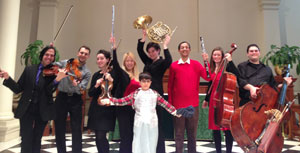 Recent News
Recent News
On Valentine’s Day, One World Symphony musicians performed its third annual morning serenade for NYC’s largest soup kitchen Holy Apostles Soup Kitchen (HASK). Before the performance, we had our only rehearsal held at 9:00 a.m. on Valentine’s Day. What was so memorable was that the staff and volunteers of HASK sat down and watched our generous musicians rehearse. They were so appreciative and attentive that you could hear their breathing. Check out photos from our Valentine Serenade for HASK here.
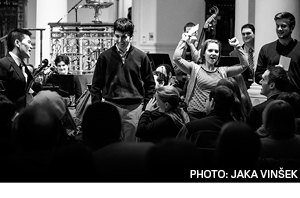 Dear addicts of music and Breaking Bad!
Dear addicts of music and Breaking Bad!
On behalf of One World Symphony staff and artists, I would like to thank everyone who came and experienced the world premiere performances of Breaking Bad — Ozymandias (2014). It was a great pleasure to share our passion with our enthusiastic audience members. Also, thank you very much for accepting the invitation to play important roles in bringing the "Bitch Aria" alive.
Yo Bitch! Experience the fun again!
View our 50 second video of our "Bitch" interaction here >>
Camera Action!
View photos from the sold out Breaking Bad – Ozymandias premieres >>
Rave Reviews!
Read the reviews >>
VOTE & BREAK BAD AGAIN:
We have received many emails requesting that we repeat Breaking Bad — Ozymandias. We are considering to fulfill the popular request by performing a movement or two from Breaking Bad — Ozymandias in One World Symphony's upcoming shows in March or May 2014. The March and May shows are detailed here >>
Our audiences are encouraged to email us and voice your preferred movement(s) from Breaking Bad — Ozymandias to be performed again in March or May 2014. The five movements are:
I. Chemistry
II. Fugue
III. The Moment
IV. Jesse's Dream ("Bitch")
V. Ozymandias
We would love to hear from you by February 7 by emailing: info@oneworldsymphony.org
Let's begin a DIALOGUE!
Your input and feedback about your recent One World Symphony experience are welcome. Did you enjoy the musical selections? Did you enjoy the audience interaction and the way we performed and shared our passion with you? Would you attend our shows if we don't program works related to TV shows? Most importantly, do you feel that we are fulfilling our VISION:
We at One World Symphony would love to hear from you! Email info@oneworldsymphony.org
Again, thank you very much and we look forward to beginning our dialogue.
Best!
Sung Jin Hong
Artistic Director and Composer-Conductor
One World Symphony
REVEALED: HEISENBERG CHORD & DETAILS ABOUT BREAKING BAD – OZYMANDIAS
“Breaking” means “change.” Walt clearly stated: “I prefer chemistry as the study of change.” Everyone paid a terrible price for his metamorphosis: his wife, his son, Hank, Hank’s wife, Jesse, Jane, Jane’s father, and of course Walt himself. “Chemistry” wasn’t simply the process of change for Walt, but it was the continuous motion of chain reactions of events of which he lost control. The plot and the narrative progress, and their pace may distract some viewers from asking the obvious moral questions: Is Walt doing the right thing? Is he good? Was he ever? What would I have done in his shoes?
In my composition, consisting of five movements, I would like to explore the question: are we all breaking bad? Are we, to some extent, guilty of the Greek themes of hubris (extreme pride) in the pursuit of arete (excellence) and kleos (glory)?
I. Chemistry
Inspired by “Crazy Handful of Nothin” (season 1, episode 6), which may have been one of the scientific highlights of Breaking Bad, the first movement “Chemistry” plants the following musical seeds:
- Heisenberg Chord: embellished polychord representing the motif of Walt’s warning: “I am the danger.”
- Heisenberg Rhythm/Heartbeat: obsessive pattern to give the sense of foreboding and being chased. Similar to Wagner’s and Berlioz’s use of motifs, whose works will be also performed alongside Breaking Bad — Ozymandias (2014), the Heisenberg chord and heartbeat will be my leitmotifs and idées fixes. The origins of the Heisenberg Chord and Rhythm are discussed in a recent interview with Mel Spencer of Classic FM, UK's favourite classical radio station.
- Aztec instruments to offer a Southwestern flavor: huehuetl, teponaztli, and quijada (the jawbone of an ass)
- Moral chaos
- Skyler’s lullaby
- The subject of Fugue (second movement)
- Kleos theme (glory): When all these musical seeds are combined and gradually unfold in continuous action, it is transformed into the Kleos theme.
II. Fugue
Influenced by Walt’s wandering and bare “fugue state” (from season 2, episode 3, “Bit by a Dead Bee”), the Fugue is a patient and subtle narrative showing the metamorphosis of Walt White into Heisenberg. The four-part fugue also uses bitonality, two simultaneous tonal centers depicting inner conflict. The keys (two separate personalities or two sides of the ego?) struggle for dominance, resulting in an inevitable collision. Which one will prevail? Or do they merge to create a new key?
Similar to the way Vince Gilligan created tension within a small space and limited environment (like cooking meth in a trailer, holding a hostage under a basement, trying to kill a fly in their lab), the Fugue follows Gilligan’s approach of harnessing and taking time to build tension.
III. The Moment
If there was a “Eureka” moment for Walt, this was it. From the third season’s 10th episode “Fly,” Walt laments and confesses his “perfect moment...”
The moving scene performed by Bryan Cranston was poignant, intimate, and tender. Musically, the explosive and moral chaos elements from the movement “Chemistry” are in the background, while Walt’s lament is treated with haunting lyricism. Jane and women singing closed-mouth vocalise with Skyler’s lullaby bookend Walt’s chilling realization.
IV. Jesse’s Dream (“Bitch”)
This is an ode to Jesse Pinkman, who may have been the moral center of the drama. Breaking Bad has clear parallels to Goethe’s influential play Faust. We can agree that Walt is Faust, but who are his Mephistopheles and Gretchen? Some may consider meth as Mephistopheles and Walt’s family as Gretchen. I lean towards Walt himself transformed into Heisenberg as the demon and Jesse as Gretchen, who is constantly persuaded by Walt to return to the dark path. My Heisenberg chord and heartbeat will be chasing Jesse, while he is trying his hardest to escape from him. At the turning point, we get a glimpse of Jesse’s dream, a sense of hope (from the final episode of the series). To show my gratitude to the fans of Breaking Bad — Ozymandias, the live audience will play a huge part in bringing this movement alive.
V. Ozymandias (from Percy Bysshe Shelley’s sonnet)
Shelley’s sonnet is devoted to a metaphor for the volatile nature of power and reveals the impermanence of human achievement. When Walt White transformed into Heisenberg, he was Shelley’s Ozymandias incarnate. I give credit to Gilligan and his team of directors and writers for choosing this poem that depicts that all rulers eventually will fall, claimed by their own self-destructive nature. The five seasons of Breaking Bad may have been building towards this moment — just like Ozymandias, “King of Kings,” Heisenberg’s empire crumbled to dust and into a “colossal wreck.” This movement opens with similar polytonal qualities from “The Moment” and builds towards the final pinnacle: the transformed and fully harvested kleos (“self-glory”) theme from the movement “Chemistry.” How will the opera end? Will it be faithful to the sonnet, or to the show?
Today's blog entry is brought to you in part by Andrew Struck-Marcell. One World Symphony will be performing the world premiere of his composition Infinity on March 2014.
BREAKING BAD — OZYMANDIAS CAST
I’d like to introduce you to One World Symphony’s Addiction cast. All vocalists have auditioned for One World Symphony over the last three years, including our current season auditions held on May and September 2013. Casting started in November and was confirmed in December.
When an artist is cast in a new opera, they usually receive a sketch of a short score in advance from the composer. All our Breaking Bad — Ozymandias vocal artists committed to the project without receiving one single note from me. Their level of patience, trust, and commitment is rare, and I am immensely grateful.
Our first rehearsal with piano and vocalists was held on Friday, January 10 at our home. It was an amazing night. We began the evening with rehearsing three smaller groups simultaneously — in our living room, library, and bedroom (I can only imagine what the neighbors thought). After the sectional rehearsal, we gathered together in the living room for our first sing-through. All the vocalists were prepared and passionate. Everyone embraced the challenges of the new score and the opportunity to bring the notes — the “blueprint” — to life.
If there’s an MVP in our dedicated cast, it is Irina Mozyleva. We first made music together collaborating in orchestrated Shostakovich songs in 2010 and continued with Cleopatra in Handel’s Giulio Cesare and Marfa in Rimsky-Korsakov’s Tsar’s Bride. Not only will she be performing as Tatyana in Tchaikovsky’s soaring “Letter Scene” from Eugene Onegin, she will be performing in the same concert as Marie Schrader and as orchestral pianist in Breaking Bad — Ozymandias! She is an absolute wonder woman. My only concern is: Can she change in time after she has sung Tatyana to perform as Marie?
José Pietri-Coimbre first performed with One World Symphony in 2005 as a violinist in James Coleman’s Memorial Concert (James was our principal violist for three years who tragically passed away after battling cancer at age 33). Ever since then, José has served as concertmaster, principal second, principal viola, and vocal soloist. His debut as a principal vocal artist reminds me how Leonard Bernstein made his debut with the New York Philharmonic as last-minute replacement. José was a section violinist in One World Symphony’s production of Janáček’s The Cunning Little Vixen. In opera, last-minute cast changes are not rare, and we needed someone to perform the challenging role of Forester during the week of the production. José was playing in the violin section and I asked him to “give it a try.” He was certainly one of the heroes in our critically-acclaimed production of Vixen. I’m looking forward to witnessing his transformation from the unassuming science teacher to the fallen emperor Heisenberg/Ozymandias.
Sonya Headlam is a beautiful soul. We first made music together when she covered roles and sang in choruses in One World Symphony shows in 2006. Ever since then, we have been active collaborators in Berlioz’s Le Nuits d’Été, Harbison’s The Great Gatsby, and orchestrated songs of Sibelius, Schumann, Duparc, and Amy Beach. When Sonya and I rehearse together, we always breathe together and really hear ear to ear. Our heartbeats become one to bring the music to life. Sonya will be making her debut as a mother at our show, as she and her husband Jesse had their first child, Noah, just three months ago. Congratulations!
Please get to know our entire vocal cast by reading their Opening Chords here.
Today’s blog entry is brought to you in part by The Flaming Meatballs. Our MVP Irina's talented daughter Leah Nikolaya is a vocalist and bass guitarist of this blues and rock band. Without Leah's support, her mother would not be able to attend our Breaking Bad — Ozymandias rehearsals.
“A LITTLE TWEAK OF CHEMISTRY”
(episode 6: “Crazy Handful of Nothin”)
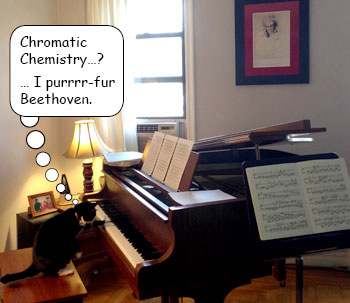
Poll: Would you like to hear a sneak peek of Breaking Bad — Ozymandias?
One World Symphony just added a concert on Wednesday, December 18 at 8 p.m. to benefit NYC’s largest soup kitchen, Holy Apostles Soup Kitchen. The show A Nordic Holiday will feature works by Sibelius and Grieg. During the post-concert wine reception, guests will be serenaded by the Robert Page Jazz Trio. Tickets are on sale now.
Also on December 18, One World Symphony may possibly feature part of the movement “Chemistry” from my mini-opera. The complete composition with multiple movements will be premiered as scheduled on January 26-27, 2014. Details and tickets are here.
Would you like to hear a sneak peek during the December 18 show? If so, please email: info@oneworldsymphony.org
Time Out New York Cover Feature
TONY’s Kenny Herzog recently interviewed me about Breaking Bad — Ozymandias (2014). Time Out featured One World Symphony’s production on the cover as a part of its 2014 Winter Preview i> “Your Perfect Winter.” Similar to earlier interviews this fall, Kenny’s questions helped me to continue to explore the drama further. For instance, Greek themes of hubris (“extreme pride”), arete (“excellence”), and kleos (“glory”) were dominant in portraying the transformation of the protagonist. Aren’t we all guilty of these to some extent? Are we all breaking bad? You can check out the cover and complete interview here.
Chromatic Chemistry
The episode “Crazy Handful of Nothin” may have been one of the scientific highlights of Breaking Bad. Mr. White is teaching his class about power of chemical reactivity. He gives the example of metal oxidation, which is gradual and imperceptible. Other times, the reaction can be violent, quick, and produces explosive energy, such as the compound mercury fulminate Hg(ONC)2 .
One of the most explosive and empowering moments occurred later in the same episode (SPOILER ALERT). Walt returned to the ruthless drug lord Tuco and threw a large piece of crystal that appeared to be meth. It exploded! The stunned and humbled Tuco asked: “What is it?” Walt responded: “A little tweak of chemistry.” Has the metamorphosis of Walt become more transparent? The cancer-stricken chemistry teacher desperate to save his family may have taken the back seat and the drug dealer may have been born. Did Walt find a new mistress who plays second fiddle to no one?
Just like how Walt has explained chemical reactions, I’m working to make my composition to have similar properties: slow, gradual imperceptible development of ideas and explosive compounds. How am I going to do this? Without giving too much away, not only am I looking forward to bringing the characters to life again through the vocal soloists, but also the full symphony.
To explore the potential dark side and the metamorphoses in the principal characters, the lowest instruments in each section will play significant roles: the bass drum, double bass, tuba, contrabassoon, bass clarinet, and the evocative bass flute. These instruments will be the floors, walls of a home. They may not have the agility as virtuoso violinists, but with their “basso profundo” presence, they will plant the seeds of brooding themes that will gradually build, combust towards the climax.
Bach, Beethoven, Pink Floyd?
Breaking Bad creator Vince Gilligan clearly had an incredible amount of patience in building his storyline and characters. He kept the cast of characters small without introducing new characters constantly (like many other shows that introduce “star” guests). He reached deep into his characters by investing in the core cast, even though they are viewed through Walt’s perspective.
I am following Gilligan’s lead as I prefer to invest in few musical motifs instead of bringing a new theme every four to eight measures without developing any relationship within the whole architecture of the work. This focused approach of investing in one single musical idea has been mastered in Johann Sebastian Bach’s fugues (check out Art of the Fugue or the popular Toccata and Fugue in D minor) and Beethoven’s Fifth Symphony. Pink Floyd’s iconic and psychedelic album The Wall possibly has an idée fixe in four notes: “We don’t need no ed - u - ca - tion.”
As for mercury fulminate, I would strongly advise not to try to prepare it at home as the explosive is highly sensitive to heat, flame, friction, shock, sparks, smartphones, just about everything...
Today’s blog entry is brought to you in part by Adam’s Pianos. Ms. Cleo Hongzinger and I are grateful and enjoying our new babygrand “laptop.”
October 22, 2013
THE BITCH ARIA...
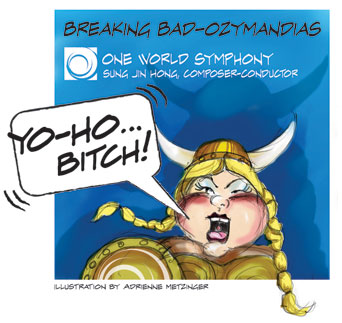 When Breaking Bad – Ozymandias (2014) was announced two weeks ago, I never imagined that we would receive so much excitement and interest from the public and the national and international press. It is amazing that the reports span the globe and in multiple languages: Turkish, Swedish, German, Hungarian, Norwegian, Dutch, Russian, Polish, Spanish, Portuguese, Chinese, Danish, Ukrainian, Czech, Romanian, and French. The BBC front page feature exceeded our expectations. We at One World Symphony are immensely grateful for the interest in Breaking Bad — Ozymandias.
When Breaking Bad – Ozymandias (2014) was announced two weeks ago, I never imagined that we would receive so much excitement and interest from the public and the national and international press. It is amazing that the reports span the globe and in multiple languages: Turkish, Swedish, German, Hungarian, Norwegian, Dutch, Russian, Polish, Spanish, Portuguese, Chinese, Danish, Ukrainian, Czech, Romanian, and French. The BBC front page feature exceeded our expectations. We at One World Symphony are immensely grateful for the interest in Breaking Bad — Ozymandias.
Is “The Bitch Aria” going to be included?
Before I address one of the most popular questions from the press and public – the “Bitch Aria” – how about we discuss the character who would sing it.
“Chemistry: it is the study of change,” Walter White taught his high school students. Like all main characters in Breaking Bad, the role of Jesse Pinkman, who would sing the “Bitch Aria,” undergoes transformation. As a high school drop-out, Jesse Pinkman could have been easily dismissed, but as the narrative slowly unfolded, he developed into a complex character who might be considered the moral center of the drama. His relationship with Walt led him to make self-destructive choices time after time that spiraled out of control, but he was compassionate and caring. In contrast to Walt’s ambitions of building an empire, Jesse’s dream was carpentry, which brought him peace and hope.
How can the “Bitch Aria” not be considered in my mini-opera Breaking Bad — Ozymandias? It would embrace the character who’s morally torn, literally pulled in numerous directions and ripped apart. The aria alone has the potential to explore Jesse’s tortured soul and battered body.
Thank-yous and Mash Notes:
All the readers who have expressed their interest in One World Symphony’s production of Breaking Bad — Ozymandias.
Vince Gilligan, the visionary creator who not only inspired his cast and crew, but hypnotized the public — still lingering and obsessed with what is possibly the Great Recession’s defining melodrama.
Dedicated musicians of One World Symphony, who are committed to bringing compositions to life, as the notes on the page are only the ”blueprint.”
Clemency Burton-Hill’s BBC feature. Ms Burton-Hill is an award-winning journalist, violinist, author, and actor. Her thoughtful interview inspired me to completely update and refresh One World Symphony’s VISION.
Charlotte Alter from TIME for breaking the news of Breaking Bad — Ozymandias.
I never thought I would ever hear Perez Hilton would say: “Wowza. Well, if it ain’t deep, it ain’t opera! And Breaking Bad has all the tragedy a show needs for a true operatic performance... so we think this opera just might work!”
Thank you to One World Symphony’s webmistress Idria Barone Knecht for all the unexpected updates and edits.
Guest Illustrator: Adrienne Metzinger is One World Symphony’s managing director, director of art/website/graphic design, photographer, stage director, cook, and mezzo-soprano who will perform as Dalila on Monday, October 28 in One World Symphony’s Burlesque Halloween show Temptation.
Today’s blog entry is brought to you by Caffee Buon Gusto in Brooklyn, where we had the pleasure of celebrating our wedding anniversary last night. We were generously hosted by the owner Nando. What would have happened if she said “no” to my proposal at One World Symphony’s sold-out Town Hall debut?
October 16, 2013
BBC Top Story Features Sung Jin Hong’s Breaking Bad — Ozymandias
Recently, I was surprised and honored to receive an email from the BBC’s Clemency Burton-Hill for an interview in regards to One World Symphony’s world premiere performances of my mini-opera Breaking Bad — Ozymandias (2014). She hosts one of my all-time favorite artistic events of the year: The PROMS.
I appreciated that she asked a question about the ethos and programming spirit of One World Symphony. It shows she has already done some research, and her question really goes to the heart and spirit of our organization. More importantly, her question inspired me to completely update, refresh, and reboot One World Symphony’s VISION.
One of the U.K.’s leading arts broadcasters and writers, Clemency Burton-Hill is an award-winning journalist, violinist, novelist, actress. As a violinist, she has toured with Daniel Barenboim and West-Eastern Divan Orchestra, “promoting understanding between Isaraelis and Palestinians and pave the way for a peaceful and fair solution of the Arab-Israeli conflict.” I explored similar themes in Eye of the Storm (2010), a symphonic poem inspired by my visit to my homeland and the Demilitarized Zone. You can listen to a clip here.
In my next blog entry, I’m planning to address one of the most popular questions from the press and the public — will I compose a “Bitch Aria?”
A week after the series finale of Breaking Bad, I have decided to compose Breaking Bad — Ozymandias (2014), a mini-opera based on the award-winning drama and Percy Bysshe Shelley’s sonnet for One World Symphony’s Addiction program on January 26-27, 2014.
How will I compose this mini-opera? Should I consider having specific characters from the drama? How about setting my music to unforgettable moments from the show? Should I focus instead on Shelley’s sonnet, devoted to a single metaphor for the pride and the unrelenting pursuit for power? It is tempting to fully dive into the universe of Breaking Bad and embrace its elements, depicting moral chaos.
Cancer became an allegory for evil for the protagonist in Breaking Bad. When Walt White was diagnosed with terminal lung cancer, we the audience emotionally supported him and forgave some of his actions, as they may have appeared to be justified. When the cancer went into remission, an intangible cancer was growing — his hubris and lust for power. Our sympathy began to slip as he transformed into the destructive Heisenberg. At this very moment, the details of Breaking Bad — Ozymandias (2014) may not be confirmed, but I hope to explore the question that the drama obsessively and hauntingly asked: ”are we all breaking bad?”
In the next three months, this page will share ideas, impressions, developments and possible trajectories of Breaking Bad — Ozymandias (2014). If you have any questions or thoughts, please email at: info@oneworldsymphony.org


